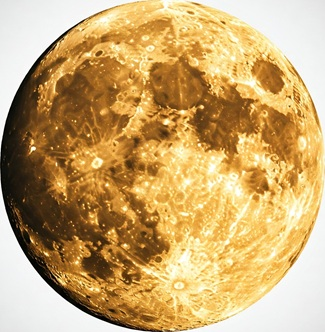
432 AND ABOVE EME NEWS
MARCH 2025
Volume 54 Number 3
Editor: Peter Blair G3LTF
Associate Editor: Matěj Petrzilka OK1TEH
Production Assistance: Frank NC1I & Bob W1QA
NEWS, CONTESTS and DXpeditions
Breaking News! Congratulations to the team at PI9RD who have just achieved the first ever Venus bounce, EVE, on 23 cm - see details below.
The undoubted operating highlight of the past month was the highly successful 23 cm dx-pedition by Alex EA8DBM to three island locations in the Pacific making 250 QSOs in total using Q65 and boosting many operators DXCC totals. He battled with strong winds at several of the locations but managed to keep the dish and mount working with running repairs when it got blown over. Sadly his plans for 13 cm operation didn’t work out this time. See his report below.
Hamad A71AW appeared from Qatar, LL55, on 23 cm with 2 x 36 ele yagis and 120 W and was worked by some of the bigger stations.
There was also some good activity on CW and digital on 13 cm around the DUBUS-REF contest period although Mr Murphy seemed to be very active as well! There was a clash for several stations with the 23 cm Pacific dx-pedition. The highest contest scores so far reported are G3LTF with 25 x 21 and SP9VFD with 23 x 21. It looks as though there were 28 stations active. Thanks to Jan, PA0PLY, for organising the Sunday 13 cm activity day, some new calls appeared there on digital, like NX9O with his folding dish.
Dan, HB9Q has added a NEWS page to his logger which may be used to post messages or links about upcoming activities and DXpeditions. If you post news, please make sure you delete them after the activity is over.
On March 14th a significant update to WSJT-X-improved was released by Uwe DG2YCB and Charlie DL3WDG explains some of the new features below
Contests
On April 4th we have the 23 cm SSB appetizer contest organized by Andreas DJ3JJ, please see his QRZ.com page for the rules https://www.qrz.com/db/DJ3JJ
On April 5/6th we have the 23 cm DUBUS-REF CW/SSB contest, the VK3UM memorial contest. Rules are at http://www.marsport.org.uk/dubus/EMEContest2025.pdf
Please note the following rule ammendment. Some operators who want to enter the DUBUS-REF contests have pointed out that the wording of Rule 3.3, concerning the use of loggers, can be interpreted in a way that restricts their activity on digital even after the contest is over. This was definitely not the intention and Joe, DL8HCZ has amended Rule 3.3 to clarify this, with immediate effect, for the rest of this year’s contests. The amended rule 3.3 is as follows:
3.3 During your moon window, the use of other communications medium such as loggers, reflectors, chat forum or the internet or packet radio to assist in making your contest CW or SSB QSOs is not allowed. For example, it is not allowed to announce your contest CQ frequency, to self spot for the purposes of making contest QSOs, to make contest skeds, exchange or discuss any contest QSO progress information, or confirm whether the contest QSO was valid or not. Your moon window is defined as 0 degrees elevation Moon rise to 0 degrees elevation Moon set. – *On 24 GHz it is allowed to use loggers and chatrooms any time to make skeds.
On April 26/27 we have the ARI Trophy EME contest, Spring Section with the rules at https://www.ari.it/english-area/eme.html
The rules for the 2025 SSB Funtests, 23 cm May 24th and 13 cm May 31st are at the end of the newsletter.
DX-peditions
April 18-26 Galapagos Islands 1296 MHz https://hd8g.com/
April 28-30th V5/ZS4TX Namibia EME DXpedition 432 MHz
May 1-4th D2TX Angola EME DXpedition 432 MHz
For more details on the last two see the end of the February 2025 newsletter.
S51LF Leon
de OK1TEH
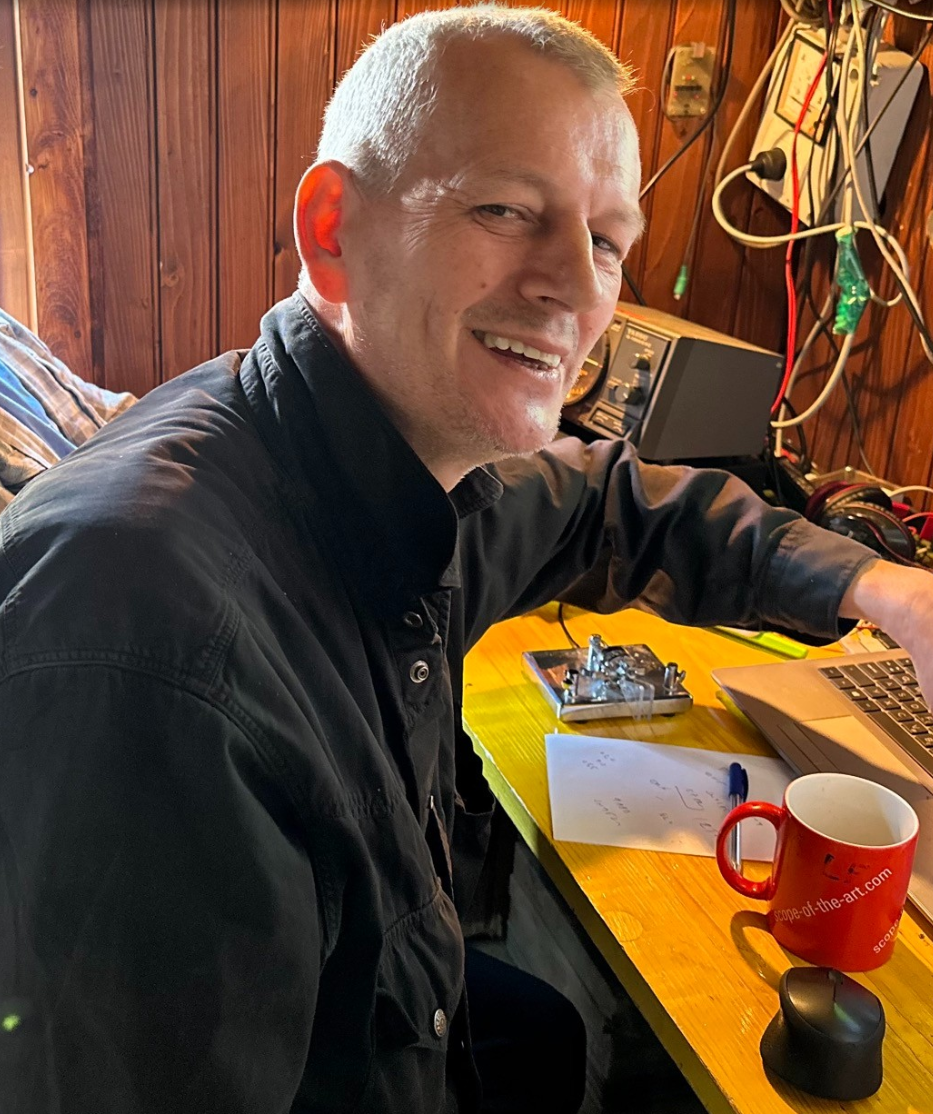 S51LF Leon - slovhf.net photo
S51LF Leon - slovhf.net photo
This months Leon S51LF became a silent key.
I worked him several times on 70 cm off the Moon, he was a good operator and technician. We also had couple of 23 cm CW contacts over 550 km during tropo contests.
All of his 70/23 cm EME rig was designed with great focus to every detail. He was a good guy, a true UHF man and he'll be missed very much ...
RIP dear Leon
SM3JQU Per
de SM3BYA
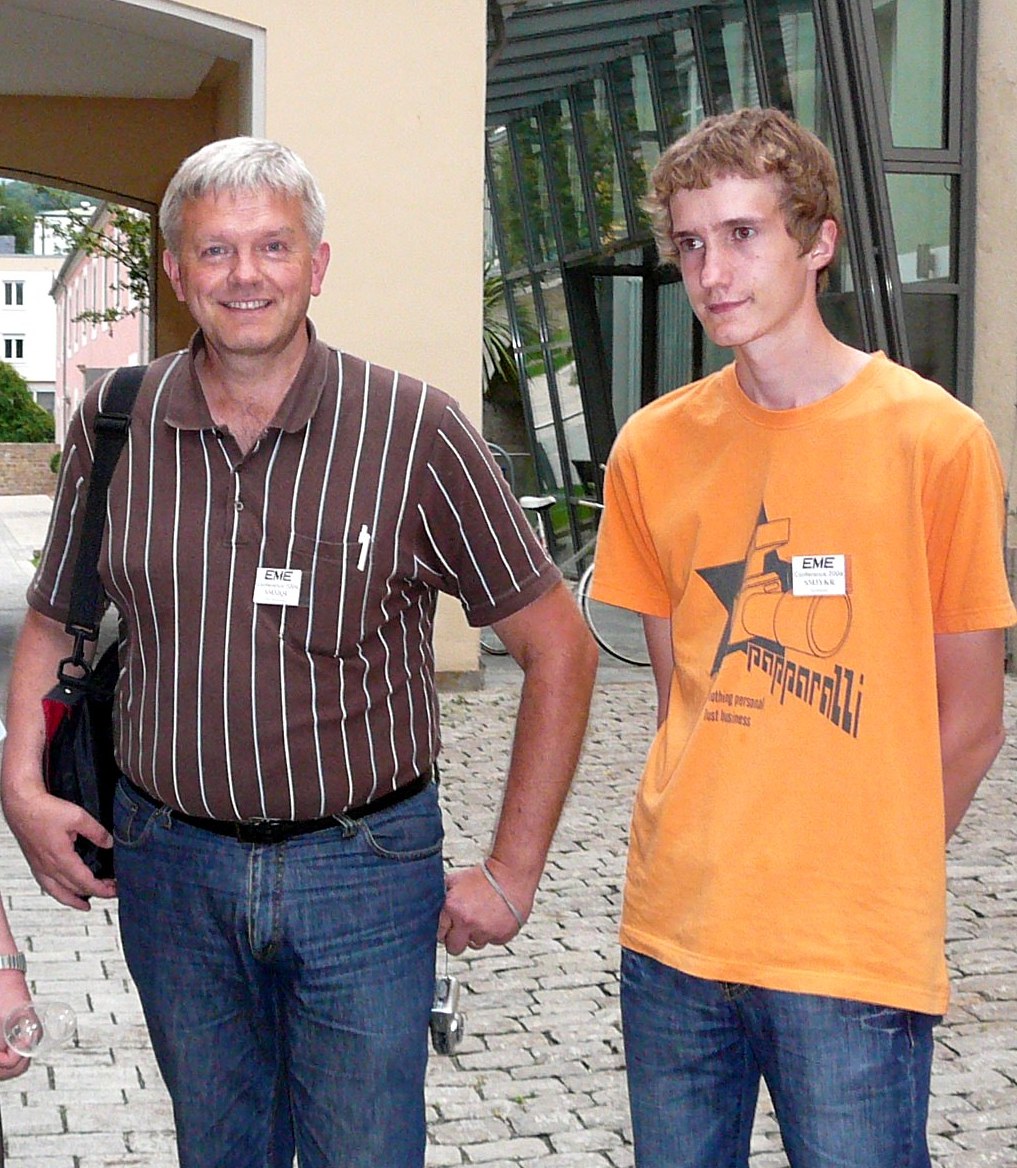 SM3JQU and his son SM3YKR - JH1KRC photo
SM3JQU and his son SM3YKR - JH1KRC photo
Yet another key has fallen silent ...
After a long fight against cancer, Per, SM3JQU joined the Silent Keys on February 1st, He was only 64.
I have known Per since the mid-1970s when he was in high school. He had just started to work toward his own license and used me as an "assistant Elmer"; his "primary Elmer" was of course his uncle Sven, SM3AH, a true old timer. Per was interested in VHF/UHF right from the beginning, but his EME activities only took off in 2003 when he learned that we were going to put the EISCAT Svalbard 32 meter dish on 432 MHz. He worked fast from there and eventually became QRV on both 432 and 1296 with a small dish but good power. Quite a few of you have probably worked him on one or both bands. He was a very good friend of Carl, SM3AKW, and living within easy reach of him Per kept an eye on how Carl was doing during his final years.
Per was not very active on the bands the last few years, partly due to his health problems. My thoughts are now with Lena, his wife, Anna, his daughter and Erik, his son.
R.I.P. Per
DK3WG Jurg
Completed QSOs this month on 23 cm using Q65-C with Alex EA8DBM at all three of his Pacific island stops. Stations worked: KH0/EA8DBM (DXCC), ON4MU, KH2/EA8DBM (DXCC), T88UM (DXCC #100), UA3MRE. That completes my 23 cm DXCC. (Congratulations! - Ed)
EA8DBM Alex
My First EME Pacific Ocean Expedition KH0-KH2-T88 is over.
The expedition has come to an end, with a total of 250 QSOs on the 23 cm band and several thousand contacts on HF. Unfortunately, once again, I was unable to make any successful contacts on 13 cm.
As always, unexpected challenges arose during the trip - at times it felt like the entire expedition was hanging by a thread. I lost my ticket to KH0, dealt with delayed luggage, a broken and shattered rotator, and faced unfavorable weather conditions. But despite all of this, I managed to overcome the obstacles and provide three new DXCCs to the most persistent operators.
On this trip, I used a new amplifier from AG6EE and a new septum from OK1DFC, specially designed by Zdeněk for a travel dish. I typically operated at 450 watts, which, as I estimate, provided an additional 4-6 dB of gain. My signal was well received, and my RX performed excellently. The Q65-30B mode proved to be outstanding, with 90% of QSOs completed using it. Only for very small stations did I switch to 60C and 120D modes. With this setup, working CW is entirely feasible, which I plan to attempt in future expeditions.
One of the most remarkable QSOs of the trip was with OE3JPC, who managed to make contact using only 2 x 56 yagis, with a report of -27/-26 dB.
The adventure didn’t end there — on my way home Turkish Airlines lost my suitcase containing the antenna and tripod. Because of this my future expeditions are currently on hold and uncertain.
For more updates and details, you can subscribe to my blog: https://ea8dbm.substack.com
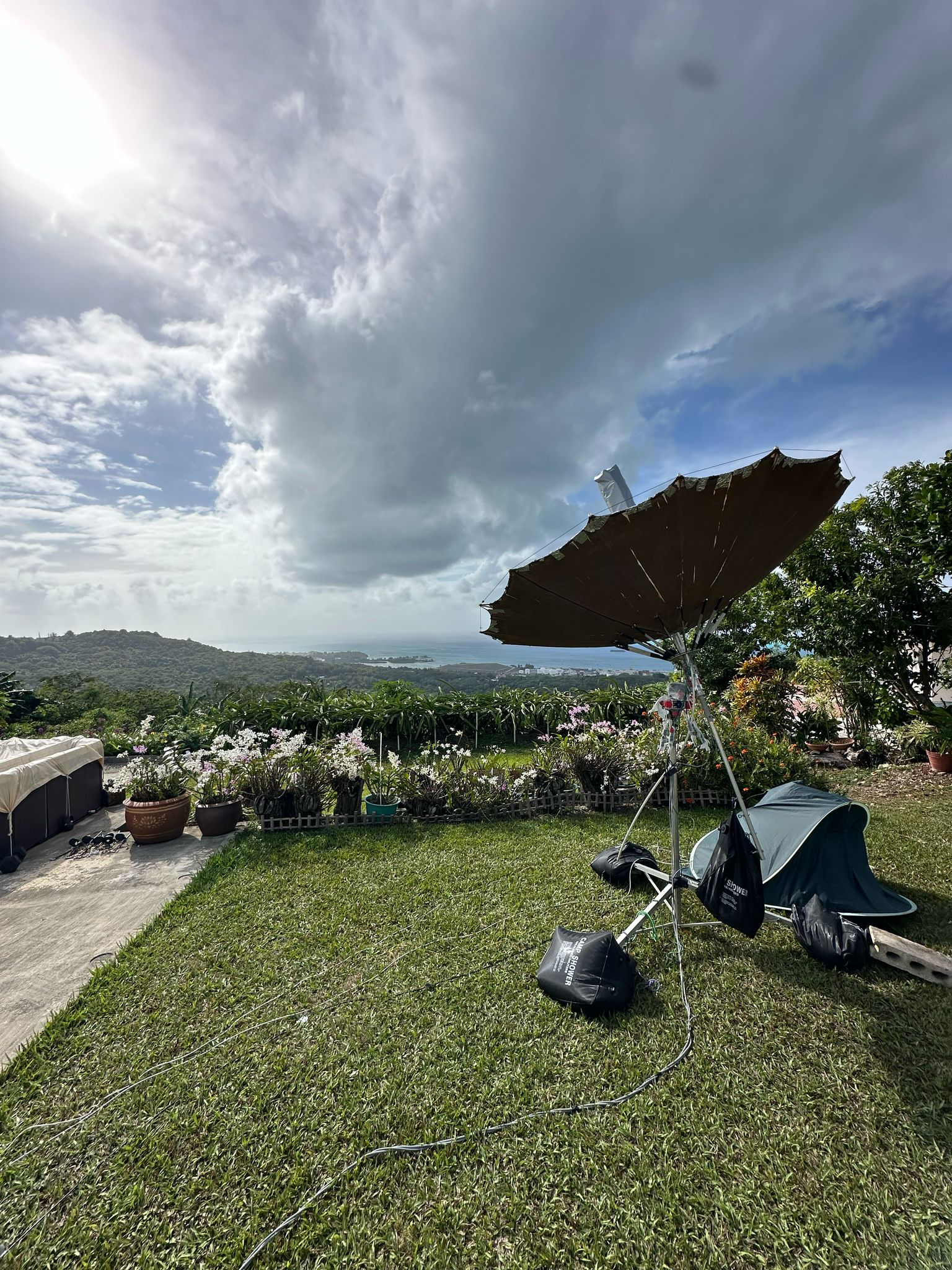 KH0/EA8DBM Saipan
KH0/EA8DBM Saipan
F2CT Guy
From my side only one interesting QSO on 70 cm with Bernie ZS4TX for my WAC!. Unfortunately I couldn't be QRV on 13 cm because of very high winds on Saturday up to 130 km/h. (Congratulations - ed!)
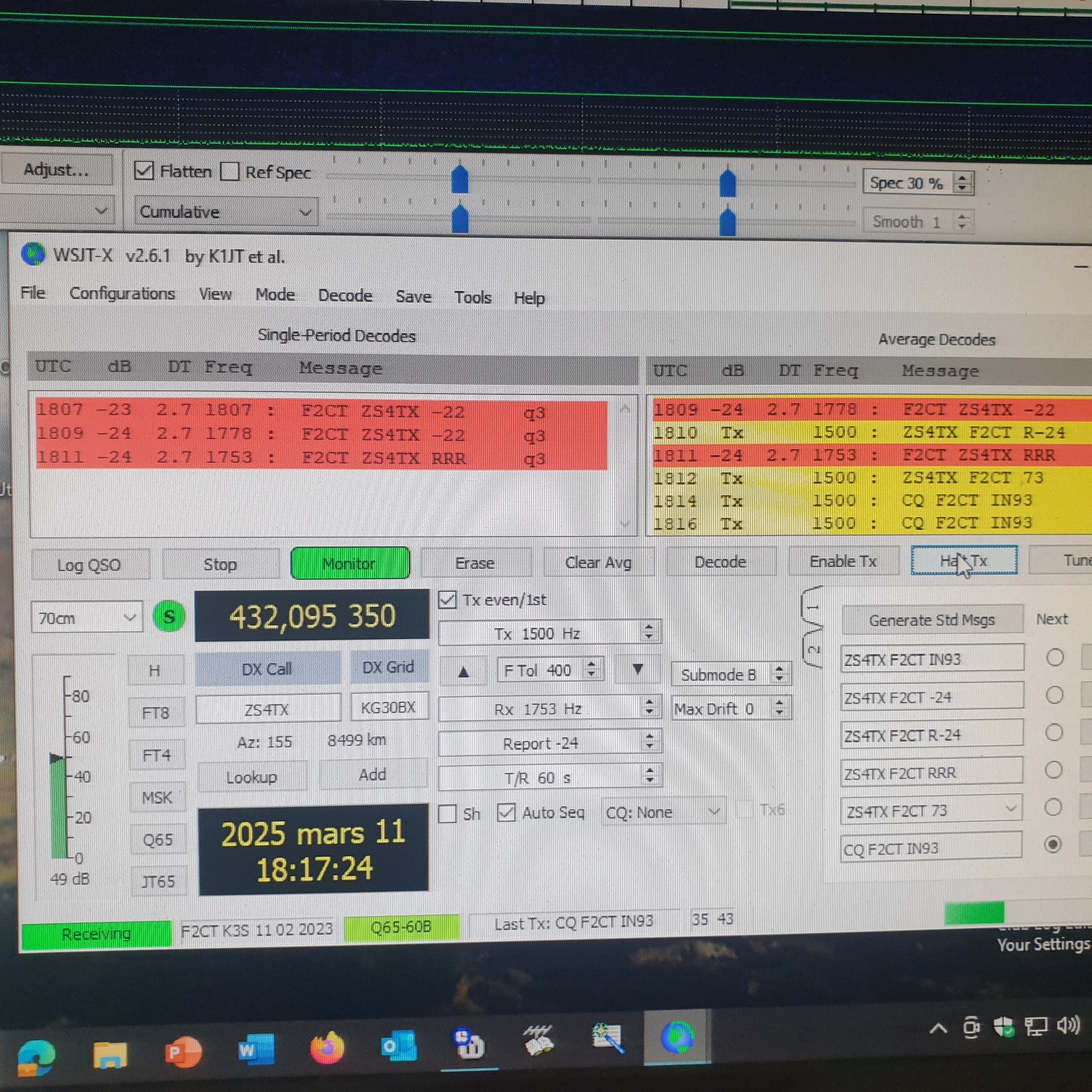 F2CT QSO ZS4TX for WAC
F2CT QSO ZS4TX for WAC
G0JDL John
This month I only worked three initials on 70 cm, DF6LH, UT6UG and PA3FVW.
In addition I also had QSOs with OZ9AAR, W5ZN, DL1VPL, ON7EQ, OK1VUM, PA2V and NC1I. I also had a few failed attempts with various stations where propagation appeared to be one-way and I was receiving a station well but they couldn’t hear my 200 W signal. The QSO with Frank, NC1I on March 3rd was a bit different to most. Conditions between Europe and the USA were good and Frank’s signal was very strong on my 2x14 array so I decided to switch to my 8-element tropo beam. After Q65 averaging did some work I succeeded in working Frank using a barefoot IC-9700 with 60 W at the antenna, no masthead preamp and no elevation. Moon elevation for me at the time of the QSO was 18°. I gave Frank a -22 report and his report to me was -30.
I was getting lower sun noise than expected an I appear to have found the cause. I have an oil-fired central heating system which had a remote oil level sensor fitted to the oil storage tank and this sent a signal to a small LCD display which gave a readout of the oil level. I replaced this with a new level sensor that sends the oil level reading to my phone and to my oil supplier. That night I noticed that the noise on 70 cm had dropped about 1.5 dB so I wondered if the old sensor was the causing noise on the band. I was able to confirm this the next day by activating the old sensor and seeing the noise increase again. A Google search revealed that the sensor was a 433 MHz device.
I was planning to upgrade my system in the summer but impatience got the better of me so I’ve now fitted a Yaesu G5500 AZ-EL rotator and ERC-Duo USB interface which finally means I no longer have to go outside and move the antennas manually several times an hour. I have the ERC-Duo connected to my Mac Mini and moon tracking is via DL2RUM’s excellent Rotor app. As the moon isn’t in a suitable position at the moment I’ll have to wait until the end of the month to find out how well it tracks the moon.
The photo shows my QSO with NC1I using 60 W.
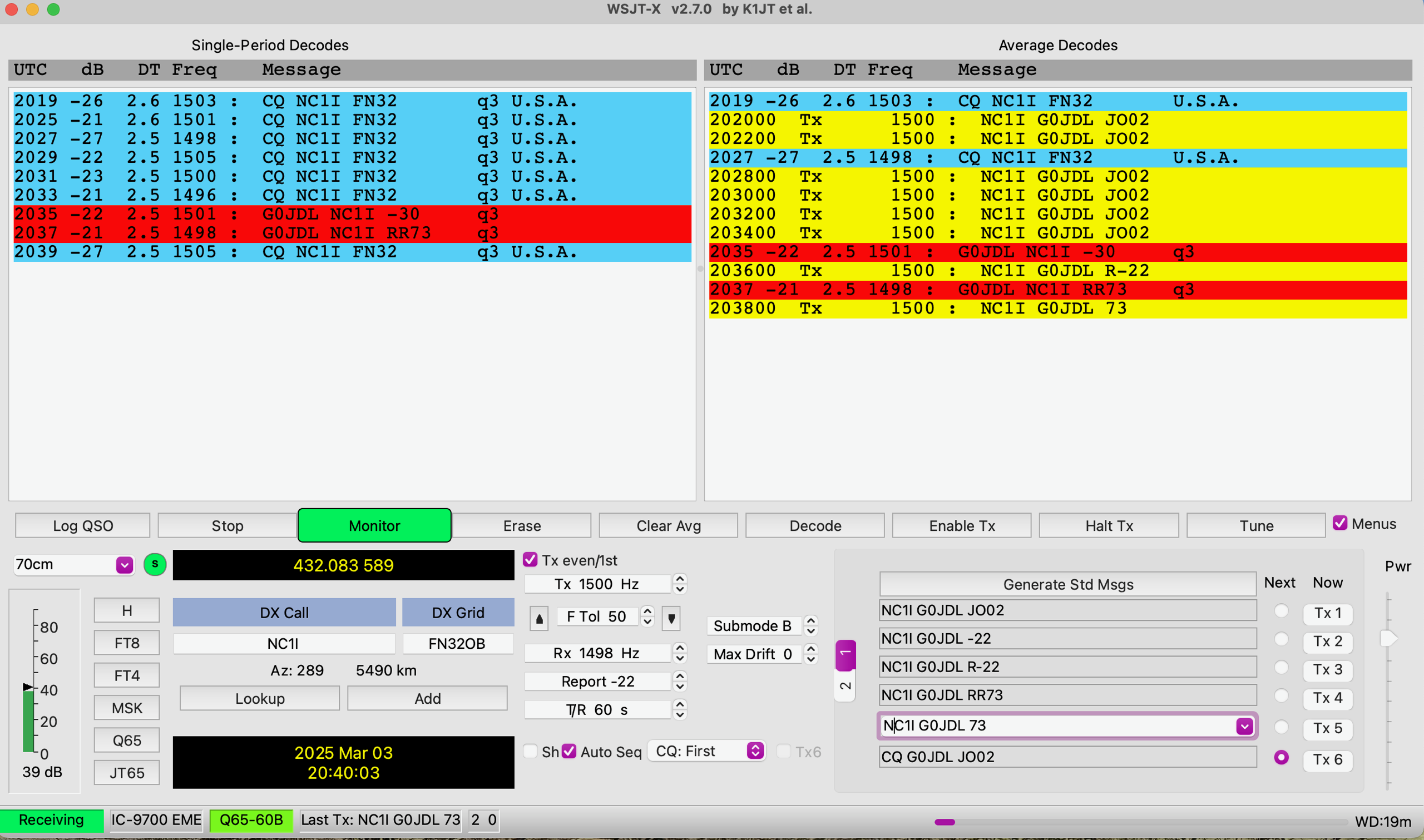 G0JDL NC1I EME QSO with tropo antenna
G0JDL NC1I EME QSO with tropo antenna
G3LTF Peter
My first task was to replace the motor-gearbox driving the declination control, the motor had developed a fault in the armature and occasionally stuck. I managed to find a “bolt in” replacement on e-Bay, however the gearbox ratio is different and it is about four times slower, I will probably fit the new motor in the old gearbox later in the year but it got me operational again in time for some 13 cm activity.
All QSOs on CW. On 3rd March I worked PA3EXV #161 and G4DDK. On 5th I worked PE1CKK #162 with his 1.8 m dish and 250 W. Moon noise at perigee measured 0.9 dB and sun noise 21.1 dB with SF160. SSB echoes were excellent but no takers.
I was all ready for the contest start, at 00:00 minus 15 minutes, great echoes... called CQ at 00:00, no power output! Next morning I found a failed TIP31 transistor in the transverter supply and fixed it before MR.
In the contest I worked OH1LRY, OK1KKD, OH2DG, OK1DFC, OK2ULQ, SP9VFD, SP3XBO, OM6AA, DB6NT, DL4DTU, SP6JLW, PA3EXV, F5JWF, PA0PLY, DL1SUZ, G4RGK, SV3AAF, IK3COJ, DL6SH, PA3DZL, VE6TA, ES5PC, G4CCH, VE6BGT and WA6PY. Total 25 x 23. CWNR was IK2RTI. In the activity day on March 9th I worked G4RFR and PE1LWT.
I suddenly realised that my 13 cm transceiver is 50 years old! The oldest part of all my 6 band EME systems. It was started in 1975 when I was building high level varactor upconverters fed by varactor multipliers for low power UHF TV transposers. I realised that this was a simple way to get to 13 cm so I built one. It lasted until last year when I had to quickly replace it with a modern mixer/ amplifier. I didnt have the time (or need?) to change the high level drive, but it should be replaced by a synth at some point.
Just for interest I took a photo of the chassis and I’ve indicated the key parts. The receive converter has two outputs 144 MHz for 2320 and 128 MHz for 2304-2302. Both of those get converted to my standard 14 MHz IF using the TS590 so I can rapidly switch between them and net so I can respond exactly on the corresponding frequency. This chassis feeds two coax lines T and R 50 m up to the 6 m dish where the PA and LNA are located.
I am looking forward to being active on CW and SSB in the April contests on 70 cm and 23 cm.
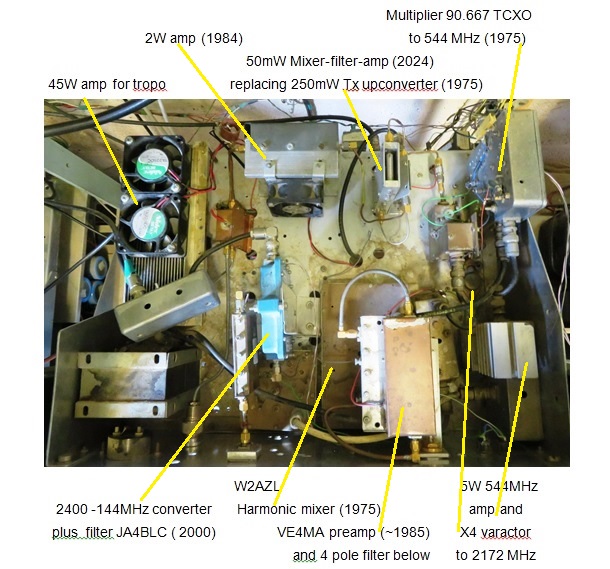 G3LTF 13cm chassis
G3LTF 13cm chassis
G4BAO John
After a welcome spell of warm weather in early March, I repaired and reinstalled my little 10 GHz EME system. As well as upgrading the 12 V DC 20 Amp DC feed to the "heavy metal" 25 W PA, I added a simple power monitor consisting of a WA5VJB 2-10 GHz PCB log periodic and a cheap Chinese detector to intercept a little of the radiated power to the dish. This gives me a power indication that should also work with my 5.7 GHz system.
I refer to my PA as "heavy metal as it's 2x 15 W ex BT units with passive heatsinks hanging from the feed arm of the 1.2 m dish. Fortunately the dish, a professional fibreglass one rated to 32 GHz is of similar "heavy metal" construction, so as long as it's reasonably balanced, it's OK. Weak echoes at around -26 and Q65E QSOs with KM0T, ON5TA, VE4MA and OH3LWP away from perigee confirmed all is well.
My initial score on the band now stands at 48 so looking for more! Barry VE4MA and Eric ON5TA reported being able to hear my tones so I'm certainly up for a CW test if anyone's big enough, having already worked "mega station" OZ1LPR on that mode. I have 5.7 GHz capability with the same dish and power but my guess is that it'll be digimodes only on that band, having worked IK0HWJ, PA3DZL and PA7JB with this setup last year.
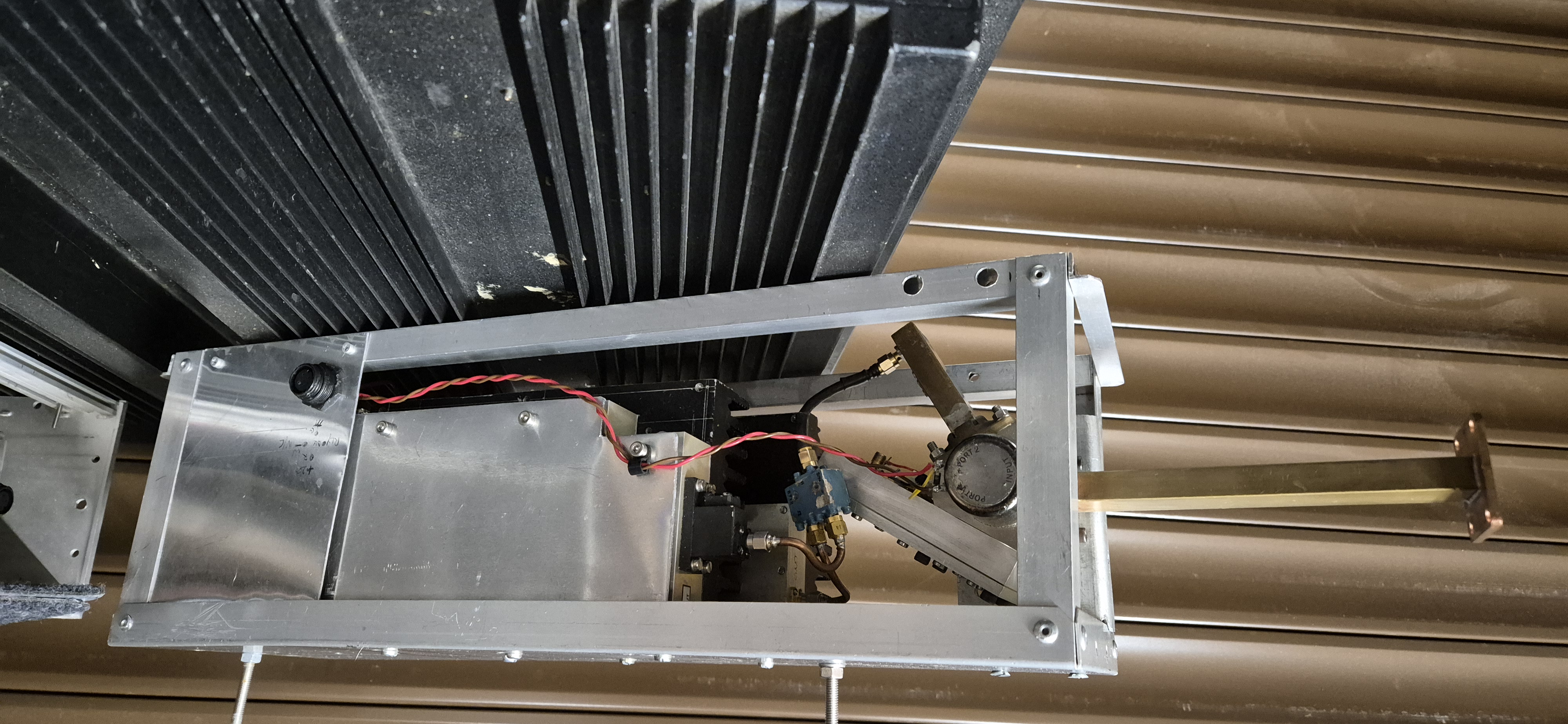 G4BAO coupling of two 15W SSPA
G4BAO coupling of two 15W SSPA
G4CCH Howard
Thanks to Alex EA8DBM for activating Saipan Is, Guam and Palau Is on 23 cm. Unfortunately, he had quite a few problems and he never got 13 cm working. The new septum feed seemed like an improvement over the patch feed that he used previously.
On 23 cm I worked the following: 02 March - KH0/EA8DBM digi #659 DXCC #131, K6FOD, KG0D. 04 March: VK3WRE digi #660, KH2/EA8DBM digi #661 DXCC 132. 05 March: DL8EBL digi #662, 06 March: IW4CPU digi #663, 08 March: T88UM digi #664 DXCC 133.
On 08 March I was on for the 13cm Dubus contest. Was late getting going on 13 cm mostly due to some stupid errors I made during the setup. My multiband transverter makes things much easier that it used to be, but its not finished, and I forgot a few things that needed doing to run on 13 cm and not 6 cm, so I was struggling for a while with no TX drive. Eventually I realised there wasn’t actually a fault, just a coax lead connected to the wrong port of a 6 way coax switch!
Also found that my Ericsson SSPA has more output on 2301 than 2320. Does anyone know of any mods to improve efficiency? Over the weekend and into the following week, I found signals to be very good, and my echoes were louder than ever before. The OM6AA choke that I added to my feed last year made a noticeable improvement. (See picture) Sun noise was 21 dB. I also used my RTL dongle SDR with SDR console for the first time in a contest – this helped a lot with finding off frequency callers. Just didn’t find as many CW signals as expected though.
I made 23 QSOs in total, 16 on CW, 7 on digi mode: SP6JLW , OH1LRY, PE1CKK digi #045, PH0V digi #046, OK2ULQ, OM6AA, SP3XBO, SP9VFD, SV3AAF, IK3COJ, DB6NT, G4RGK, PA3DZL,OK1KKD, DL6SH, G4SDG digi #047, KN0WS digi X band, PA3EXV digi #048, G3LTF, PA0PLY digi, OM1TF digi 049, WA6PY and ES5PC.
On 09 March: G4RFR digi, G4RFR, SP9VFD digi #050, #SV3AAF digi #051, VE6BGT, PA3EXV CW #139 and KN0WS digi X band.
On 12 March: By now the Moon was very low, but managed to complete easily with Charlie with his new setup on 13 cm DL3WDG digi #052.
On 14 March: Tried again with Charlie this time on CW. DL3WDG fail Charlie blew his LNA.
On 17 March: Stopped up late, and with the Moon almost too low for EME, to try with Eddy PE9GHZ. Eventually the Moon appeared out of the trees and we completed very easily with Eddy’s signal easily audible, so CW will be possible. PA3EXV digi, PE9GHZ digi #053. The picture shows the moon about 30 minutes after the QSO with Eddy, I could still hear echos.
Looking forward to the 23 cm contest next month.
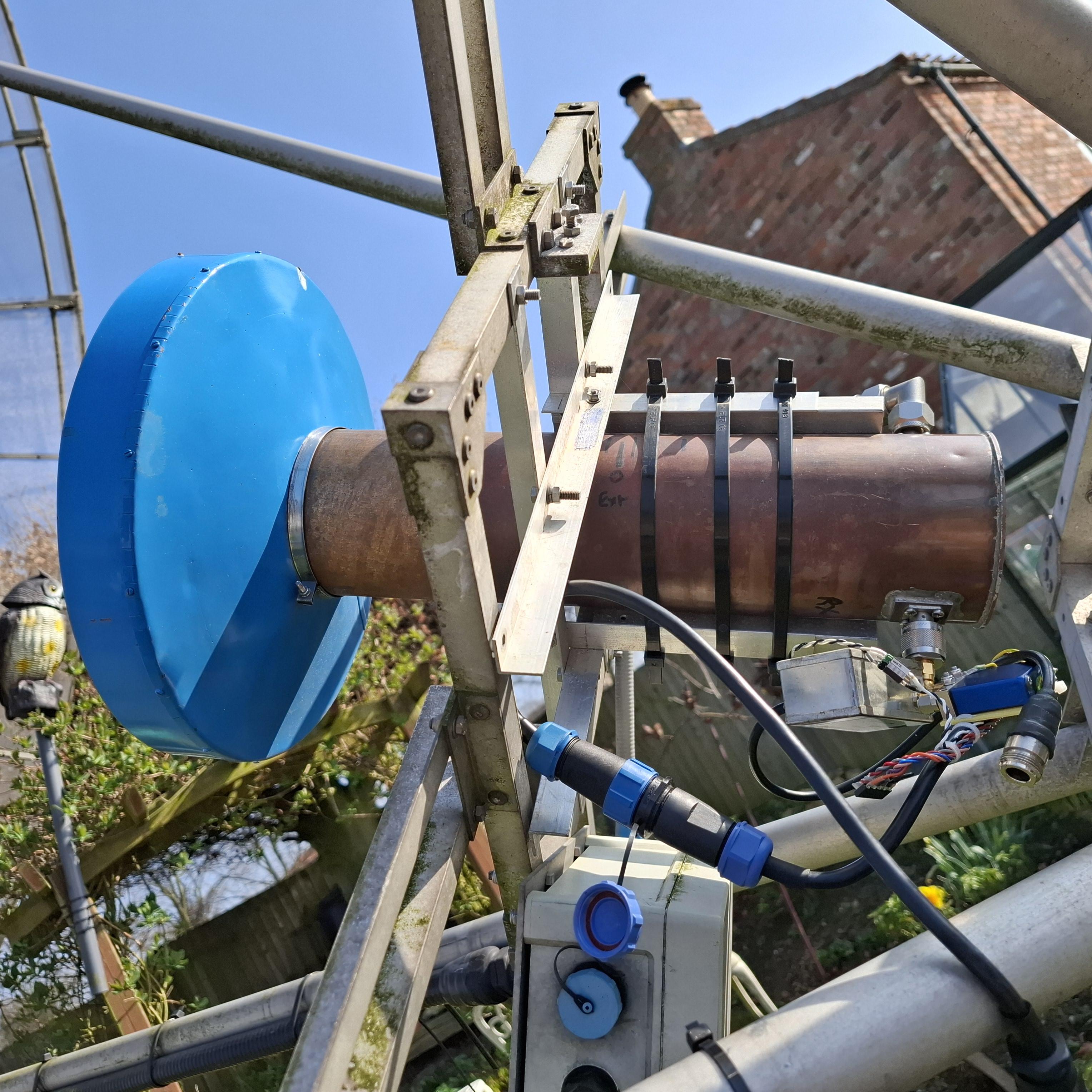 G4CCH 13cm feed
G4CCH 13cm feed
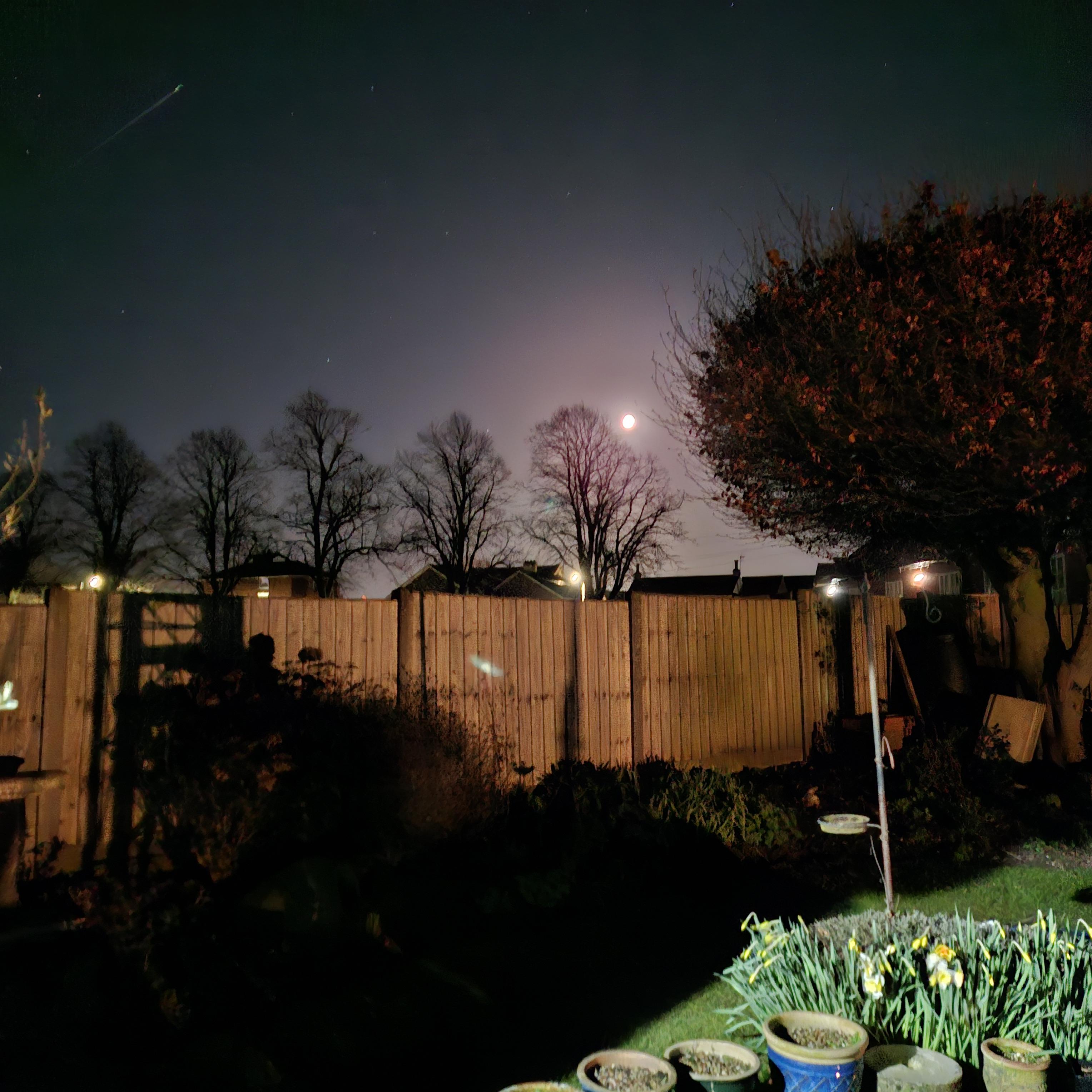 G4CCH moon at 6 deg elevation
G4CCH moon at 6 deg elevation
G4RFR / G3YGF Julian
Sunday 2nd March we were on 10368 MHz with 200 W. It was quite busy, and we worked: IK3GHY -18/-4 best-13/-3 (1m2/32W), IZ0JNY -21/-5 best-18/-5 (1m/20W), GW3TKH -12/-3, ON5TA -6/+2 best-5/+2 (2m4/30W), OZ1LPR +1/+1 (2m4/300W), EA1IW -14/-1 (1m8/20W), VE4MA -11/+1 (2m4/50W), W2HRO -12/+1 (2m4/20W), I6YPK -17/-4 best-16/-4 (1m/25W), SA5IKN -21/-17 best-21/-7 (0m9/27W) and CT2GUR -14/-5 (2m3/40W). Moon noise was 2.5 dB (Moon+N)/N, Moon beacon 19dB/6Hz.
On 2320 MHz with 70 W we worked: G4DDK -21/-14 best-15/-14 (2m3/150W) and PA3EXV -22/-14 best-16/-11 (2m3/150W).
On Wednesday 5th March on 2320 with 70 W again, we worked: G4DDK -14/-15 (2m3/150W) and PE1CKK -15/-18 best-12/-18 (1m8/250W).
On 10368 with 200 W we worked: G8RWG -/-6 (1m rx only), ON5TA -6/+3 (2m4/30W), F5IGK -11/+0, GW3TKH -13/-4 (1m2/22W), IW2FZR -11/-1 (1m8/35W), KM0T -11/-5 (1m8/60W), OE9ERC -16/+0 and EA1IW -13/-3 (1m8/20W).
On Sunday 9th March on 2320 with 70 W, the activity period was very busy. In 3 hours in the afternoon we worked: G4CCH -16/-7 best-10/-7 (5m4/100W), OK1KKD -9/-12 (5m/500W), PA3DZL -7/-10 (4m/350W), IK3COJ -14/-14 best-13/-14 (4m/120W), PE1LWT -16/-13 (3m/80W), PH0V -22/-22 best-20/-22 (2m5/80W), G3LTF 559/559 (6m/250W), DL6SH 559/559 (8m/75W), G4CCH 559/559 (5m4/250W), PA0PLY -12/-14 (3m/200W), SP3XBO -12/-13 (3m6/350W) and PA3EXV -15/-14 (3m5/150W). Sun noise was 12.7 dB (Sun+N)/N, 1st Sidelobe noise was 1.9 dB (Sun+N)/N. Echoes were ~10dB S/N/6Hz.
We have added a PCB log-periodic and diode sensor mounted on the edge of the dish (if you add an attenuator it could be at the centre of the dish) as an overall monitor that all is well. It checks power out on all bands from 2.3-10 GHz on one meter - it is easier than having separate directional couplers on each PA/feed and is independent of them. Indications are typically a few mW on 2320, and less on 10 GHz. We may get its output calibrated.
On 2320, our broadband 2 MHz wide noise meter gives very stable noise measurements, but it can be susceptible to other signals around the 2 MHz band that the 190 kHz wide SDR does not see. It is a good idea to check for weaker signals in the 2 MHz bandwidth with a narrower filter from time to time.
We have about 14.5 dB of (Sun+N)/N noise on 1.2 GHz, and are fitting a rather heavy 180 W SSPA behind the dish with about 0.5 dB feeder loss up to the transverter/feed. We hope to be on in the April 1.2 GHz contest.
G4RGK Dave
Its been over a year since I last put the 13 cm station together, so I knew I would have to start a week before the Dubus 13 cm CW event to find all the parts. For once it all went well and I had a working station 3 days before the start. Sun noise was down on what I would expect and I put this down to the stressed dish profile needing correction. Its probably been 5 years since I last did it. So Saturday came round, a nice calm day which made operating easier. I am still steering the dish with a surplus Mobility Scooter drive through a chain sprocket reduction system, there is too much backlash in the system to keep the dish on the Moon in even a slight wind on 13 cm. I have a very limited Moon window due to Leylandii trees so I couldn't see the Moon until around 1530 UTC.
Once I got the dish clear of the trees there were some very big signals around, I went on to work: G3LTF, OH1LRY, SP9VFD, PA3DZL, G4CCH and SP6JLW but I heard many more wkg other stations: DB6NT, IK3COJ, OM1TF, OH2DG, SP3XBO, OK2ULQ, OK1KKD, OM6AA and DL6SH, were all good workable signals but I couldn't find them calling in the time I had available before I lost the Moon at 21 UTC. Personally I would prefer the Dubus contests to be be over two days to give me more time with my limited window, but I understand the reduction in activity doesn't warrant it any longer. The station: 4.6 m stressed dish, RA3AQ feed, DDK preamp, Ericsson PA around 180 w.
G4SDG Chris
Some years ago I had a few EME contacts on 144 MHz with my old terrestrial system but the tower that had my 17 element Tonna on it has been repurposed for LF use so I tried a different route to get back on EME. I'm using a 1.9 m RF Ham Design mesh antenna that the previous owner extended to 2.2 m. It is on a modified polar mount driven by linear actuators from old TVRO antennas but unfortunately the azmuth/GHA travel is rather limited.
The control system is homebrew using Arduinos and HH12 resolvers. Equipment is an FT-817 and SG Labs transverter and a modified Nokia amplifier with 3 * BLF8G22LS transistors. The LNA is a G3WDG unit previously used on AO-40. Feed is a septum design. I'm limiting transmit power to around 70 watts until I have more confidence in the overall system. I managed my first contact with OK1DFC on Friday 7th and then on Saturday 8th added OK1KKD, PE3EXV, PA3DZL, F1RJ, G4CCH, PA0PLY & DL6SH. Many thanks to everyone for the 13 cm activity.
KN0WS Carl
Since it takes quite a bit of time and effort to unpack and set up my gear on various bands, then to tear down again, I tend to focus my EME efforts on weekend contests that allow digital modes (when I might also try a bit of CW). In the winter I am limited to my smaller backyard dish in the snow and I have not yet had CW success with that, so I do other things during the January through July DUBUS contest weekends.
This past weekend I made an exception on the 13 cm band since it had been suggested that after the contest was done, perhaps there might be some ongoing activity. My WSJT-X software only occasionally allows CAT control of my IC9700 radio, so to do “CFOM” with folks, I just dial my self-doppler into the radio’s RIT offset and then transmit half of that value below the target frequency. Only on 3 cm is the self-doppler too great for my radio’s RIT adjustment to do this.
Using my 2.4 m dish and a septum feed on March 8, I worked G4CCH (15), DL1SUZ (22) and had an initial with PA3EXV (21). On March 9 I worked PA0PLY (28), VE6TA (15), OK1DFC (8), G4CCH again (15) and had an initial with N6NU (20). Heard, but not worked were PE1CKK (22), DL6SH (14) and F5JWF (12). I do not know if they were monitoring 2304.
Moon timing could have been a bit better, since my moon window did not start until about 22:20, which meant EU was mostly ready for bed. It would be nice for guys like me if DUBUS rules allowed CW operators to switch to digital and peek at a logger once the contest was officially over, instead of being banned from sites for the remainder of the moon window, regardless of the number of moon hours still available. Regardless, it was good to have my first EME QSOs of 2025. I hope to see you guys during the ARI spring contest and again this fall.
(Rule 3.3 was not intended to restrict activity in this way and has now been revised, see elsewhere in this newsletter. Ed)
NC1I Frank
The following 70 cm initials were added since my report last month: OE6ISP (30DB/21DB). This was Stefan's first 70 cm EME QSO and he was using 1 x 11-element yagi and 40-watts. PA5BAS (21DB/27DB). This was Bas's first 70 cm EME QSO and he was using 1 x 16-element yagi and 62-watts. OH3KLJ (12DB/11DB). Mika was using 4 x 23-element yagis and 400-watts.
I added the following initials on 23 cm: AC2AC (24DB/04DB). Fabio was using a 2.4-meter dish and 8-watts and this was his first 23 cm EME QSO. KH0/EA8DBM (15DB/19DB) for 23 cm DXCC #101. F5KSE (09DB/13DB). I do not have any information on this station. KH2/EA8DBM (20DB/21DB) for 23 cm DXCC #102. T88UM (15DB/19DB) for 23 cm DXCC #103.
I would like to thank and congratulate Alex EA8DBM for yet another very successful series of DXpeditions!. Once again Alex had a number of challenges but found solutions to each one. His final results were very impressive.
I'm looking forward to the upcoming 70 cm DXpeditions to Botswana, Namibia, and Angola.
The northeast U.S. continues to have a number of high wind events. So far, my 70 cm array and 6.1-meter dish have survived without any serious issues. Hopefully my luck continues.
OH1LRY Janne
Our station was ready for 13 cm contest as we initially tested new 8 m antenna in autumn ARRL contest. This time we also had borrowed a new PA from Ari OH3LWP. Ari had built a new one and joined the team. In the beginning of the contest we had high winds and our AZ-gear was slipping with horrible bangs. Luckily wind speed dropped in the evening so all turned out good. Petri OH3MCK and Ari OH3LWP were operators and they worked 22 QSOs in total. We are still using old feed which is optimized for f/d 0.35..0.40 while 8 m dish is f/d 0.5. Long term plan is to build W2IMU type feed horns.
OK1KIR Vlada
In March we were closely watching Alex 23 cm expedition. Alex started on Saipan Is. with lightweight OK1DFC’s septum feed producing the great improvement of his station. We worked KH0/EA8DBM on Mar 2 using Q65-30B with great signals -13/-9 as new #613, DXCC and field QK #92. When Alex moved to Guam Is., we worked him on Mar 4 with Q65-30B KH2/EA8DBM as new #615, DXCC and 1st QSO with OK. Later Alex moved to Palau Is. and we worked him on Mar 8 with Q65-30B as T88UM (-9/-12), new # 616.
Unfortunately, Alex was not able to repair 13 cm equipment, so it remained a challenge for his next planned expeditions. However, operation on 23 cm with his big 2.4 m umbrella dish at wind gusts showed that it will not be an easy task on 13 cm.
On Mar 4 we also worked using Q65-60C with VK3WRE (-11/-8) as #614 and later on with ON4MU.
During DUBUS contest on 13 cm we partly just searched for any new CW stations without success. So, we swapped to 23 cm for Alex. After returning to 13 cm we worked using Q65-60C with IZ2DJP #103, PE1CKK #104, PH0V #105 and PA3EXV #106.
On Sun, Mar 9 during 13 cm activity we repeated Q65-60C QSOs with PA3EXV, PH0V and worked G4DDK, IK3COJ. Further worked with OM1TF as #107 and DL6SH as #108. With DL6SH also worked CW #199. On Mon, Mar 10 waiting for potential 13 cm signal from Alex we worked using Q65-30B with OE9ERC (+1/+1) as #109 and PA0BAT as #110. With CW worked PE1LWT as #200.
ON5TA Eric
More and more small stations are appearing on 10 GHz EME, some of them putting out very respectable signals with their 1 m or 1.2 m dishes.
On February 2, I was very pleased to QSO with Max SA5IKN who had a surprisingly good signal with a 90 cm dish in his shack, beaming through an open window.
On March 8, another nice surprise! While testing with N6RMJ (1,2 m / 28 W), he told me that NJ6D was copying me every sequence and wanted to have a try. Chuck has a very typical terrestrial station: 76 cm offset, just 10 W into a W1GHZ 10 / 24 GHz feed, all coax, no W/G. To our amazement, the QSO was very easily completed!
I use a 2.4 m offset dish, 35 W at feed on 3 cm and a DU3T preamp.
OZ9AAR Carsten
I have now had my 70 cm EME system up and running for around 7 months. So far I have had QSO with 118 different stations (two of them CW (G3LTF and DL9KR), the rest on Q65).
So far everything has been stable and running without any faults or hickups. Initially I struggled with low sun noise, I did a lot of testing and measuring and finally found out that the built-in preamp of my IC-9700 worked less than optimal. Details about this is on my webpage (also a PDF document with details is there).
My 70 cm W6PQL PA module is mast mounted and remotely monitored/controlled by my REPAM module and Dual RF Head, and has been running very nicely since installation. Mast mounting the PA allows me to have only 0.6 dB loss from the PA to the feedpoint(s) of the antennas. Currently I have 400 W at the feedpoints. I also changed my preamp to a WD5AGO cavity preamp (2 stage), using that I could disable the internal preamp of the IC-9700. Since then, things have been running smooth. The "only" challenge I have (like most) is noise on the 70 cm band from a million electronic devices (half a million of those in my own house).
Currently I am waiting for the mechanics (tower, elevation parts etc) and a 4.8 meter dish kit (all from Zdenek OK1DFC). This will enable me again to become QRV on 23 cm EME. My plan is also to include 70 cm in the dish at some point.
I have documented everything (I hope) of my current project(s):
70cm EME system:
https://www.moonbounce.dk/hamradio/ham-radio-current-systems/70cm-eme-system.html
4.8 meter dish project:
https://www.moonbounce.dk/hamradio/ham-radio-current-systems/4.8m-eme-dish.html
During construction of my station (I was away from hamradio for 20 years), I have developed a number of projects/products, these can also be found on my webpage. Most of these are with enough details so you can produce your own copy, for those that want finished devices, I have a limited number available of each.
Among these projects/products are modules for power measurements, remote control (via Ethernet/internet) of PA, QRO combiners for 23 and 70 cm, PTT Expander for IC-9700, overcurrent protection/switch for PA modules etc. Most of these products can be found here: https://www.moonbounce.dk/forsale.html
I also made a couple of PC applications, SimpleCalc and SkyScanner (and SatTrack). These are also available from my webpage.
At this point, I want again to say a HUGE "thanks" to all that have helped me getting everything up and running, it is SO nice to see all the helpful people, both on moon-net, HB9Q reflector and in private emails! Since I was last active on EME (from 1993 to 2004), things are indeed much easier now!
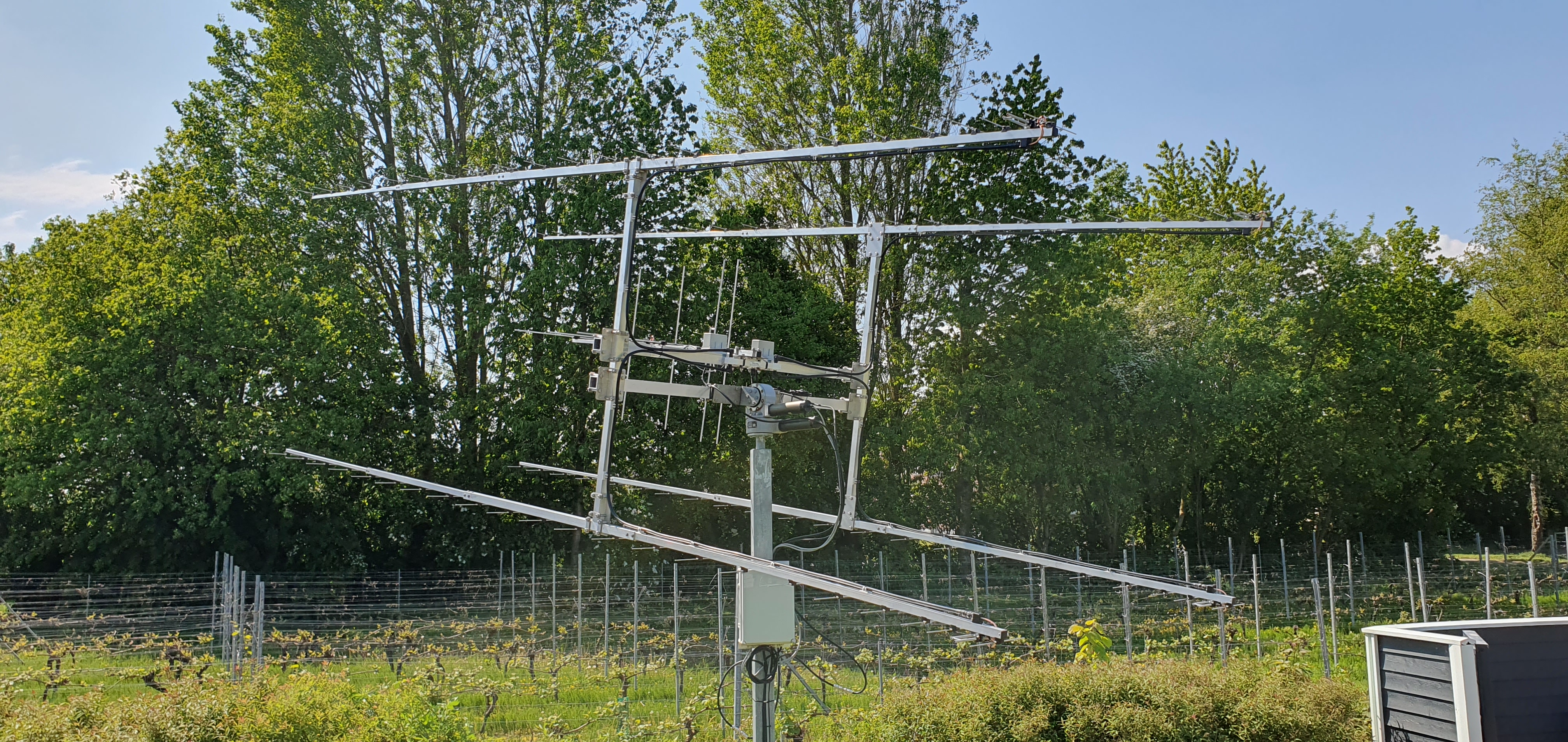 OZ9AAR 70cm EME system
OZ9AAR 70cm EME system
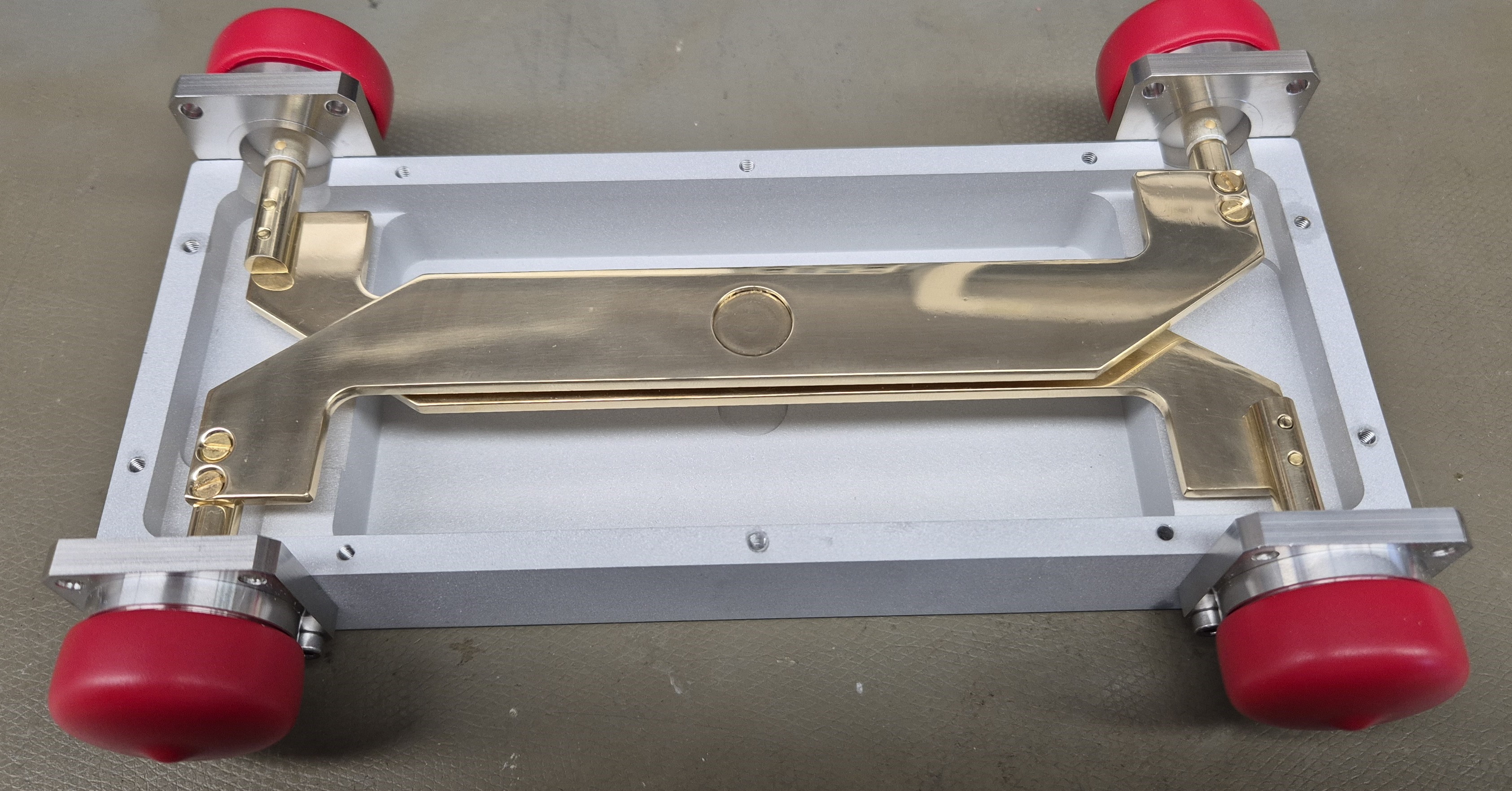 OZ9AAR 70cm QRO combiner
OZ9AAR 70cm QRO combiner
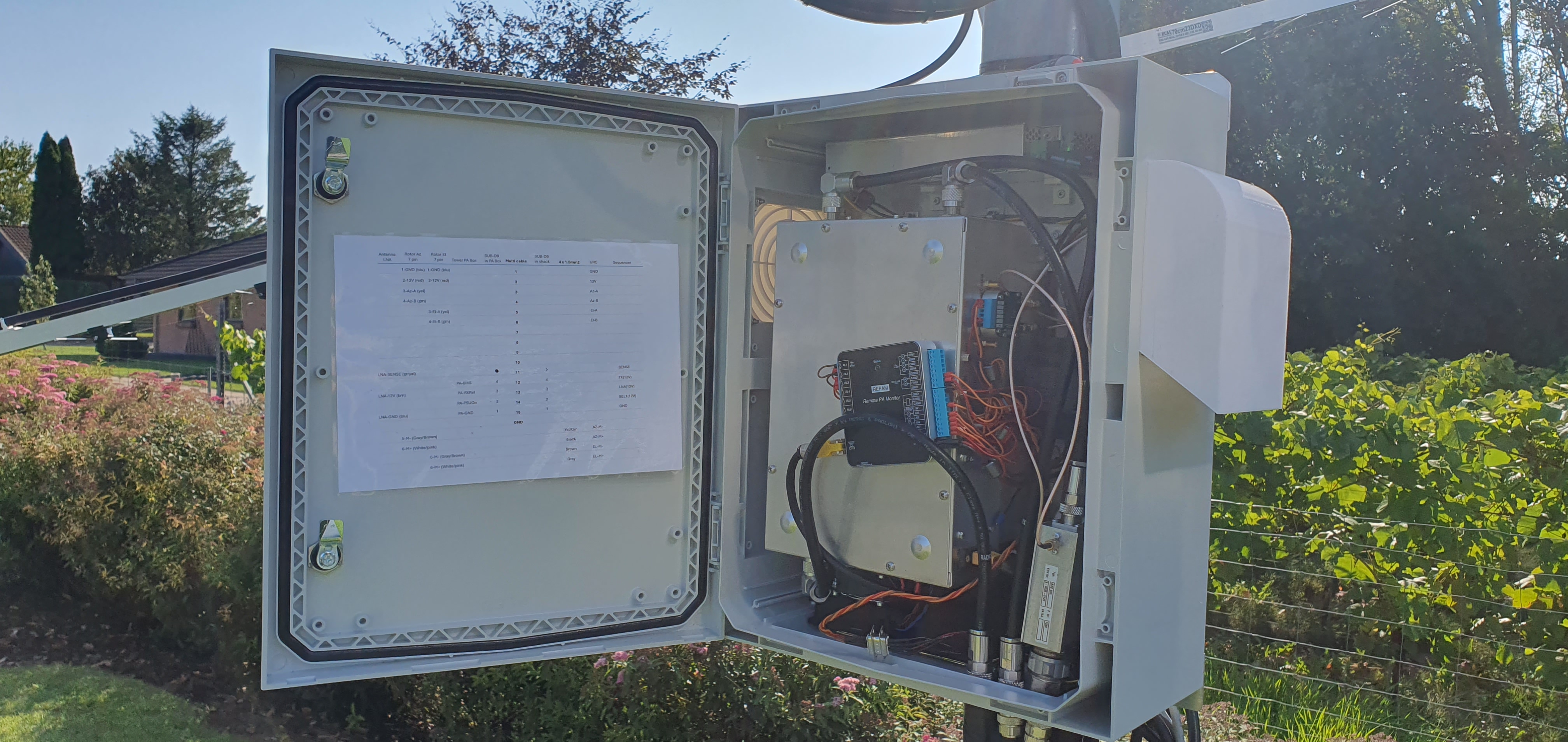 OZ9AAR Mast mounted 70cm PA
OZ9AAR Mast mounted 70cm PA
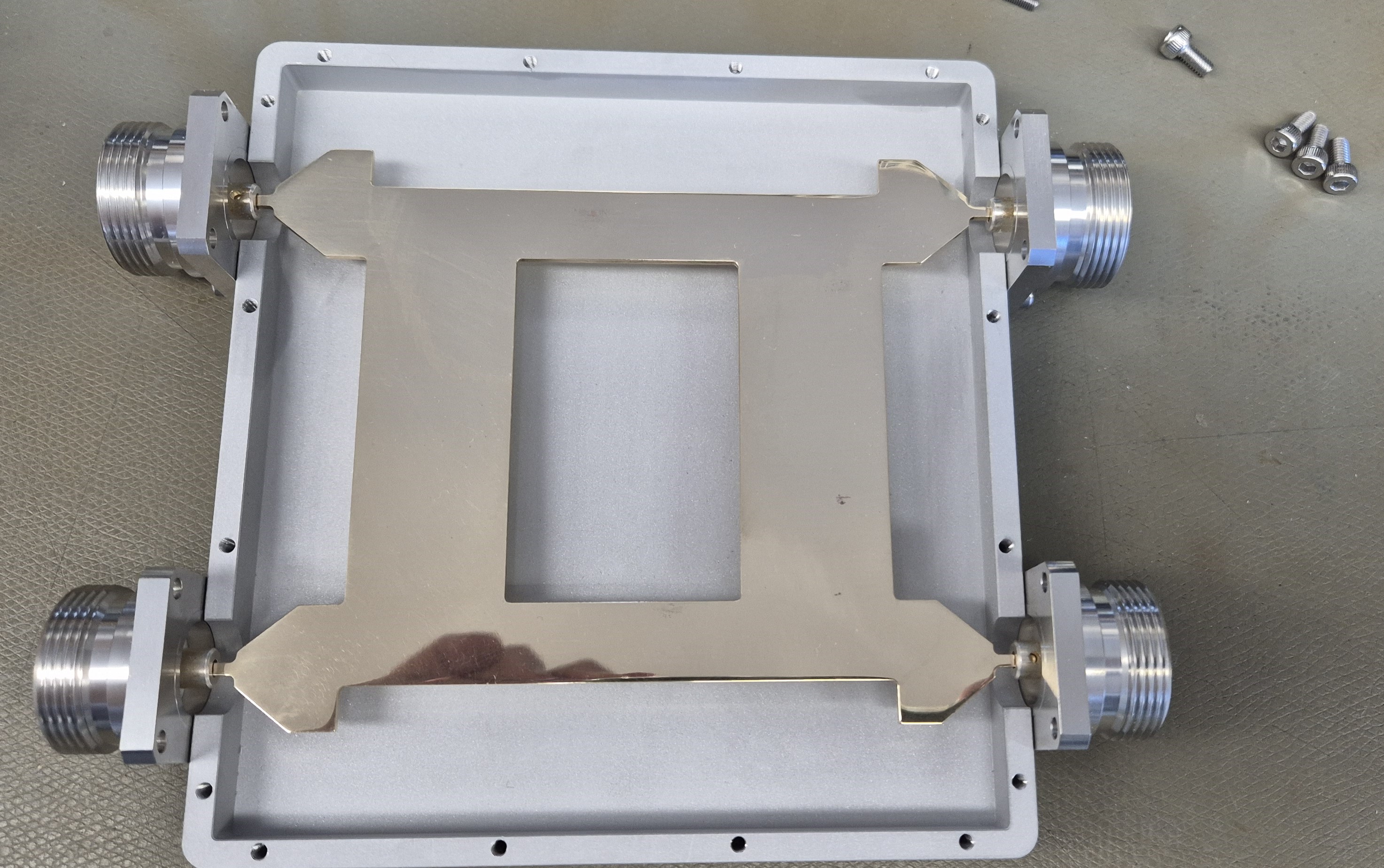 OZ9AAR 23cm QRO combiner
OZ9AAR 23cm QRO combiner
PA3DZL Jac
On 1296 MHz I made 10 intials and 4 new DXCC's. Great activity again from Alex EA8DBM activating 3 new DXCCs and also a very nice first show of Hamad A71AW from Qatar.
Worked: AC2AC #, KHØ/EA8DBM # and DXCC 110, W3TI #, VK3WRE #, KH2/EA8DBM # and DXCC 111, IK7EZN, PY2BS, ON4MU, RY4C #, CT1FFU, K3SK, R6CS #, NC1I, G4KLX, 9H1BN, GØHIK, IK2DDR, F4DWB, SP3TLJ, PE1LWT, T88UM # and DXCC #112, and A71AW # and DXCC #113
Overall some nice activity on 2320 MHz, less activity during the Dubus CW Contest than last year but very pleased with the new initials. Congrats to the newcomers for building nice equipment and getting QRV on 13 cm. Thanks to Jan, PAØPLY for organizing and motivating activity around this Dubus CW weekend.
On 2320 Mhz: 5 initials Worked: PA3EXV # CW and Digi, PAØPLY CW and Digi, OM6AA, PE1CKK # CW and Digi, SP3XBO CW and Digi, OE9ERC, OK1KKD, PHØV #, SV3AAF, G4SDG #, OM1TF, G4DDK, G4RFR # and OK1DFC
During the Dubus contest I had 17 CW QSOs with: F5JWF, DB6NT, OH1LRY, OK1KKD, SP6JLW, SP3XBO, OK2ULQ, PE1CKK, OM6AA, SP9VFD, IK3COJ, G4RGK, SV3AAF, G4CCH, DL6SH, G3LTF and VE6TA
PA0PLY Jan
Prior to the DUBUS contest I prepared my system but encountered some serious problems. It all started with no RX or TX at all. I removed the transverter from the dish and tested it in the shack. And it all worked fine.
Afer investigation it was found that the PLL in the DEMI transverter did not lock at the correct frequency, most likely due to the freezing cold temperatures outside.
At Gerries, PA3EXV, workshop we tested the PLL-LO and found that the used frequency was quite close to the edge of the range. We modified it a bit to have 1088 MHz more in the center of the frequency span for this PLL. Now I could copy both PA3EXV and G4DDK, but after one call all this disappeared and also no power indication. What the heck?
Again removed the transverter and tested the SSPA without any problems; easy 200 Watts, but the preamp was dead. We replaced the MGF4919 in the DDK preamp and mounted all again. Same thing occurred, I heard Sam but after one TX cycle the preamp was dead again and no power indication in the shack. But my signal was on the moon.
I measure the TX power using the other leg of the SMA safety switch in the RX line. After a night of sleep I concluded that this relais might be the culprit. After removal of the relais and put the detector on the RX port of the feed, my TX indication was ok. Thus I tested the SMA relay. It was sticking most of the time in the powered position for RX. That of course caused both no tx power indication and the damage of my preamps.
A new SMA relay was mounted, thanks again, PA3EXV, and after many efforts to repair the G4DDK preamp I finally removed the second stage and added a gain block. This was at least a more or less stable situation, although the noise floor was "dancing" up and down. I measured 13 dB of sunnoise and the first QSOs were logged without further problems.
On March 6th I worked Q65: DL3WDG, PE1CKK, G4DDK, OK1DFC
Before the DUBUS contest started on March 8th, I encountered another Murphy problem. My slow speed AZ positioning for tracking did not work any more. So on the Saturday morning I inspected the PWM module and got it working again.
During the DUBUS Contest moonpass I worked:
CW mode: OH1LRY, SP6JLW, SP9FWD, G3LTF.
Q65 mode: OK2ULQ, F5JWF, PH0V, G4SDG, DL6SH, G4CCH.
On March 9th event, I worked:
CW mode: JA6XED, VE6BGT.
Q65 mode: VE6TA, OM1TF, KN0WS, OK1KKD, PE1LWT, IK3COJ, G4RFR, SV3AAF, OK1DFC.
I concluded it was worth expanding the DUBUS contest event with an all mode moonpass the next day.
For the 24Ghz group we have great news: After a long period of design now we have the first batch of DU3T WR42 waveguide switches produced. The switch comes with a control board and needs 12 VDC power. The board provides a delayed output for a SSPA as well as a 9 VDC output for the LNA. For the latter there is a choice to leave the dc power on all the time or have it switched with the TX/RX sequence. The sequencer already provides a delay but it can be additionally extended using a switch. Further details are on my website. https://www.pa0ply.nl/wp-content/uploads/2025/02/21b-WR42SW-datasheet_revA.pdf
You may have seen I renewed my WEBsite, https://www.pa0ply.nl thanks to my son. For the EME database https://www.pa0ply.nl/eme-directory/ I will update it once per month. So please inform me of your updates by email.
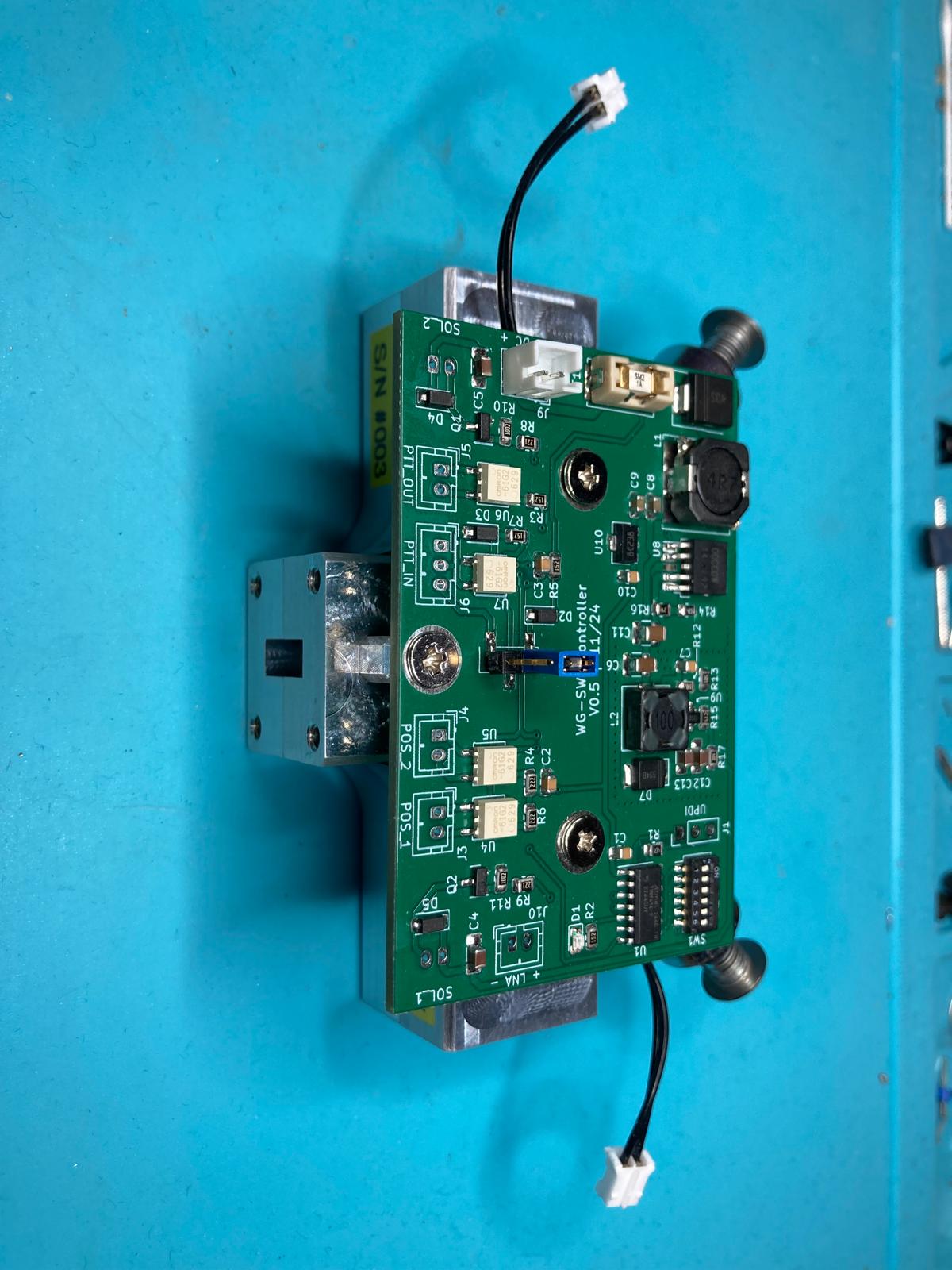 PA0PLY DU3T WR42 waveguide switch
PA0PLY DU3T WR42 waveguide switch
SP9VFD Raf
I'm still impressed signals strengths at 13 cm band. Using the same dish but much less power at feed than on 23 cm, own echo has also sounding very nice! I was active 13 cm Dubus EME Contest on March 8th and had worked random CW with: WA6PY, VE6TA, SP6JLW, OH2DG, JA8ERE, OH1LRY, OK1KKD, DL4DTU, G3LTF, SP3XBO, OK2ULQ, DB6NT, PA0PLY, DL1SUZ, OM6AA, SV3AAF, G4RGK, PA3DZL, G4CCH, DL6SH, F5JWF, VE6BGT, ES5PC.
I had heard several times JA6XED when he stayed on CQ around 2400.070MHz. I tried to call him on his CQ freq and 2320MHz Tx cross as well, but without any success.
Outside of the Dubus contest in March, I had also some nice 13cm Q65D QSOs with: OK1KKD, PH0V, SP3XBO, G4CCH, OK1DFC, PA3EXV
My current 13 cm setup: 640 cm dish, WA6PY LNA (0.3 dB NF, 33 dB gain), PWR at the feed (2304 MHz 180 W, 2320 MHz 150 W, 2400 MHz 60 W), TRV Kuhne MKU 23 G4, Icom IC-9700, SDRplay RSPduo.
Thanks a lot for a couple of random QSOs and new inits. I have uploaded LoTW, I will be QRV Dubus 23 cm leg on April 5th/6th.
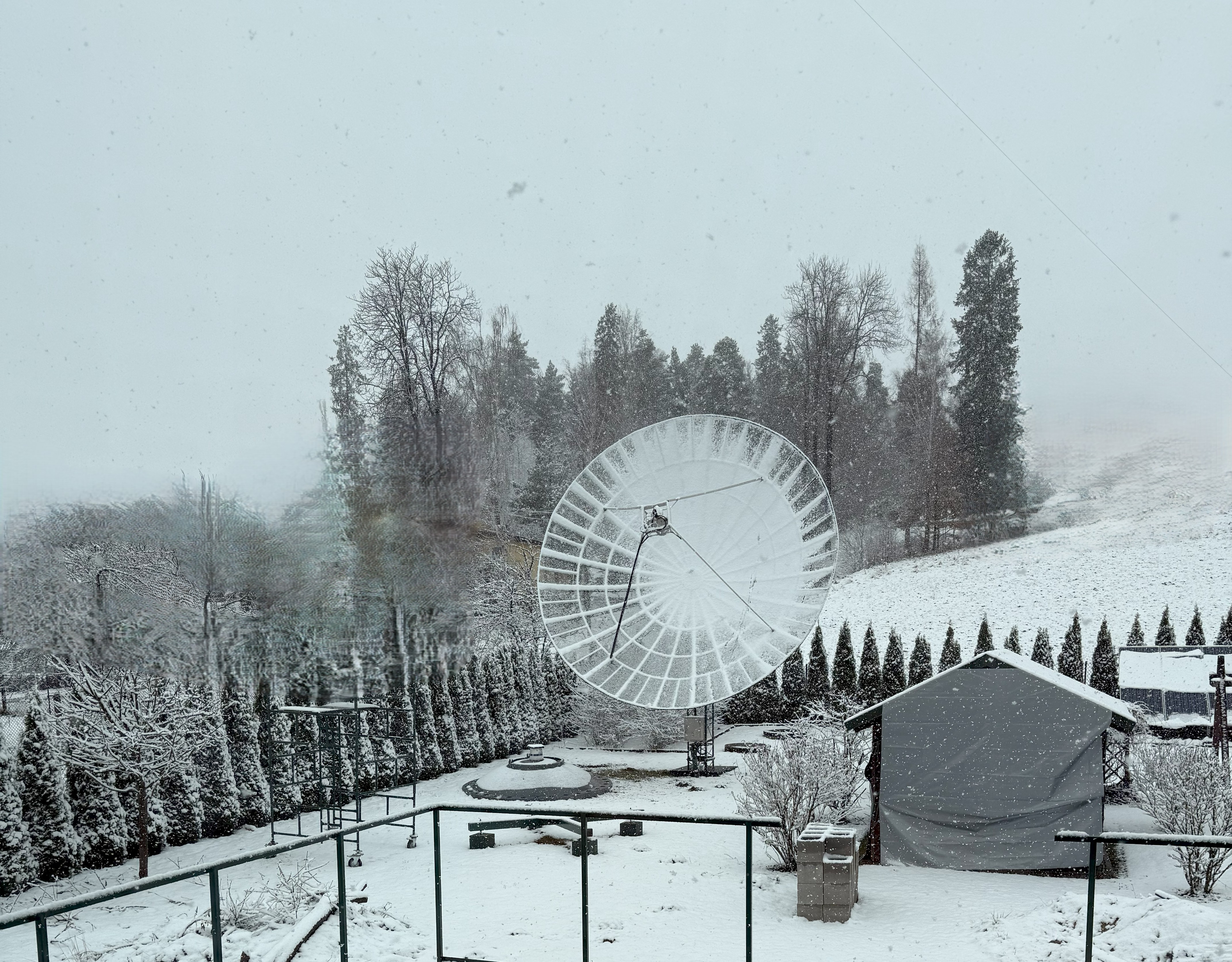 SP9VFD dish
SP9VFD dish
VE6TA Grant
I got on for the 13 cm Dubus contest and worked the following; OK1DFC, WA6PY, #SP9VFD, OK1KKD, VE6BGT, PA3DZL, G3LTF, ES5PC, SP6JLW, OH1LRY.
Moderate activity this year with some very strong signals but a lot of QSB. I also got on Q65 this weekend and primarily focused on new stations on
2320 MHz. The digital modes seems to help fend off the Sat QRM a bit so it helped with a few of the weaker stations.
Worked the following on Q65: #PE1CKK, OK2ULQ, #PH0V, #F1RJ, F5JWF, #PA3EXV, #OM1TF, DL1SUZ, #PA0PLY, #NX9O, KN0WS.
WA6PY Paul
I was QRV on 8 Feb 2025 on 432 and QSO'd: UA3PTW VE6TA SP9VFD and heard OK1VUM G4RGK. Unfortunately they were on relatively strong unstable carrier drifting up and down. I was calling CQ hoping that they would hear me. I was TXing with vertical polarization, echos came on quite stable horizontal polarization. Received stations were rapidly changing polarization, I was switching, but on vertical I had few dB higher local noise floor.
On 8 March on 13 cm I had a very short window to the EU at the very beginning of the contest and at the very end. QSO'd: OK1DFC VE6TA SP9VFD OK1KKD OE9ERC OH1LRY G3LTF G4CCH ES5PC SP6JLW VE6BGT. On my western horizon I was calling CQ for 2.5 hours looking for JA on 2304 listening on 2400, VK on 2301, but had no luck. In my case, EME contest limited to 24 hours is unfortunate. It is good enough for EU and US East Coast, but I am located too far to the west.
I plan to be on 1296. I wonder if I should spend time calling on 1298 for OH stations or should I call only on 1296 and listen also on 1298 similar to cross band on 13cm?
I am working on getting more power on 24 GHz for June contest.
Dwingeloo's First Venus Bounce
PI9RD / PA2DW Dick
On 22 March 2025, we used the Dwingeloo telescope to successfully bounce a radio signal off the surface of Venus. At the time, Venus was in its closest approach to Earth at about 42.000.000 km. Such a conjunction happens when Venus is between the Sun and the Earth, and happens approximately every 580 days.
‘Earth-Venus-Earth’ (EVE) bounces were extensively performed in the 60s and 70s to make radar images of Venus. More recently, in 2012, the Arecibo telescope in combination with the Green Bank telescope made a very detailed map of Venus. The first, and only until now, amateur EVE was achieved in 2009 by AMSAT-DL from the 20 m Radio telescope at the Bochum Observatory (Sternwarte Bochum).
The Dwingeloo telescope was commanded to transmit a 278 second long tone at a frequency of 1299.5 MHz. Since the light travel time to Venus and back was about 280 seconds, we could receive the reflection of our own signal afterwards. We repeated this cycle four times.
While Dwingeloo received its own echo, the Stockert radio telescope, operated by Astropeiler Stockert e.V., also successfully received Venus’ echo of Dwingeloo’s signals. The receptions in Stockert were stronger than those received in Dwingeloo, since the Stockert receiving chain is a bit more sensitive.
The data analysis consists of correcting the received data for both the expected Doppler shift and the rate of change of this Doppler shift due to the rotations and relative motions of Earth and Venus. After channelizing the received signal in 1 Hz frequency bins, the echo of the transmitted signal should fall exactly in the predicted bin.
The preliminary analysis already shows a 5.4 sigma detection for Dwingeloo-Venus-Dwingeloo, an 8.5 sigma detection for Dwingeloo-Venus-Stockert, and a 9.2 sigma detection when combining the signals of Dwingeloo and Stockert.
We were planning to send complex modulated signals to perform more analysis on the correlations between transmitted and received signals. Unfortunately the transmitter, mounted in Dwingeloo’s focus box for the occasion, started failing after four successful transmissions. We will postpone these other experiments to the next Venus conjunction in October 2026.
In the preparation for this experiment, we collaborated with the Deep Space Exploration Society, who were also preparing an EVE experiment of their own, and the Open Research Institute. During the day of the experiment, we had a lot of help from present CAMRAS volunteers. A big thanks also goes to the volunteers of Astropeiler e.V. for observing with the Stockert telescope.
A technical write-up of this experiment and the data reduction is in the making. This article and additional info can be found on the Camras web site:
https://www.camras.nl/en/blog/2025/first-venus-bounce-with-the-dwingeloo-telescope/
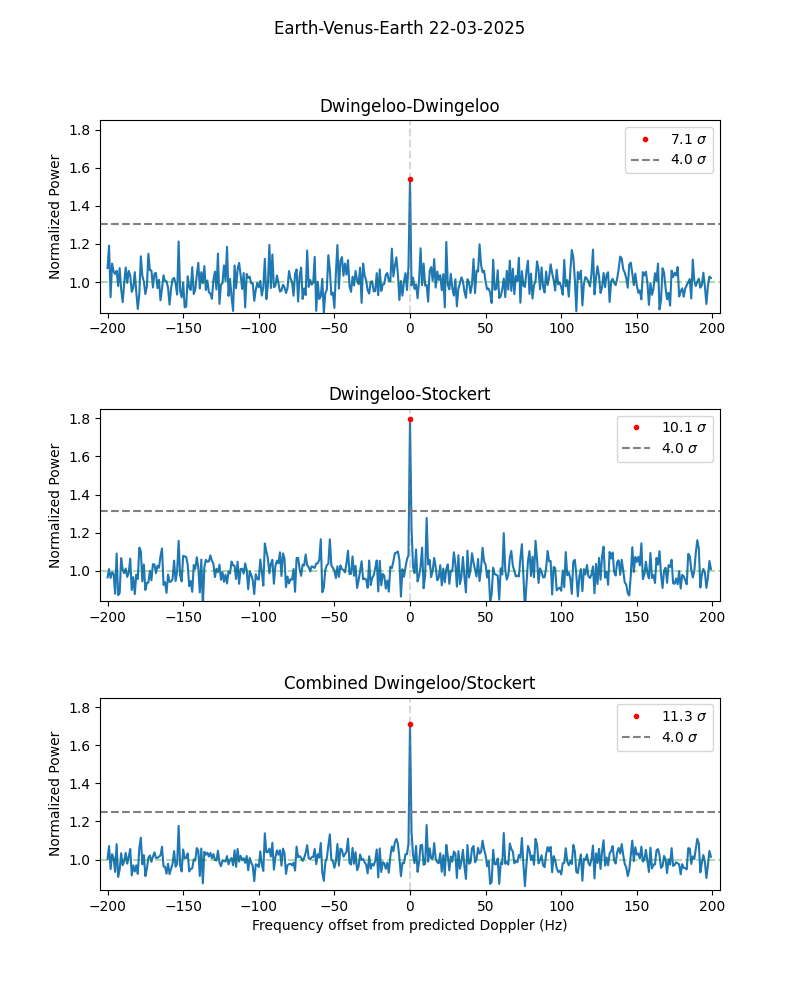 PI9RD EVE reception
PI9RD EVE reception
The distance to Venus is a rough 42 milion kilometers, so one can imagine a considerable (ca. 340 dB) path loss. Especially the reflectivity of Venus (uncertain but estimated 10-15%) and the (unknown) doppler-spreading of the signal are contributing to that.
For this occasion we received a special time-limited (2 hours) license to increase our RF output by a factor 10, but the total link budget still indicated only a marginal echo could be expected in 1 Hz bandwidth. We used a 1 kW amplifier, made by Hans PE1CKK, and mounted it directly at the feed. This was no trivial job, see the attached pictures. The telescope amplifies that by 48 dBi, so you can do the math.
Since we had received a special experimental license from the authorities, we could not use PI9RD but had to choose something ourselves. So we used “EVE25RD” for our identification.
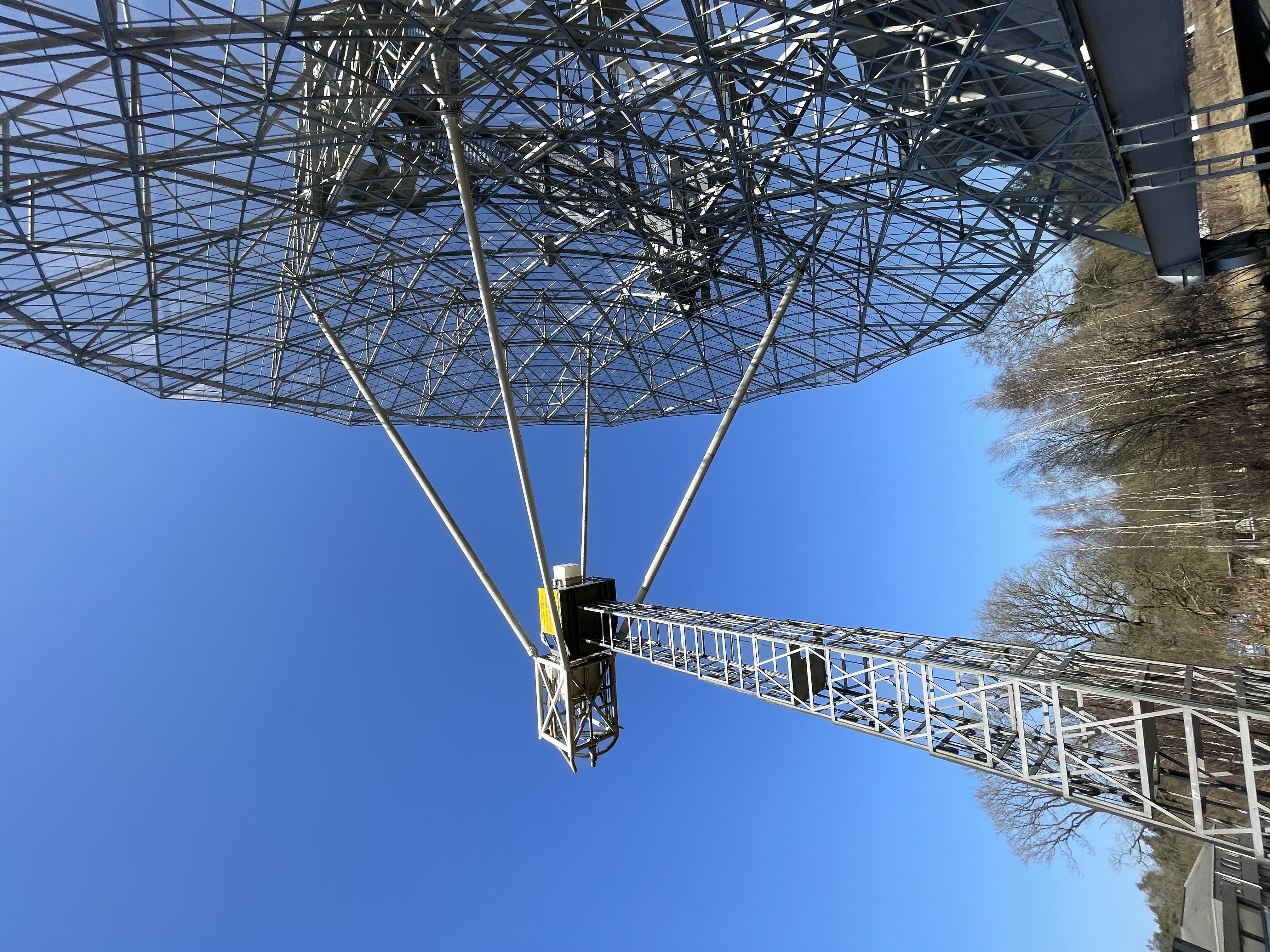 PI9RD dish maintenance position
PI9RD dish maintenance position
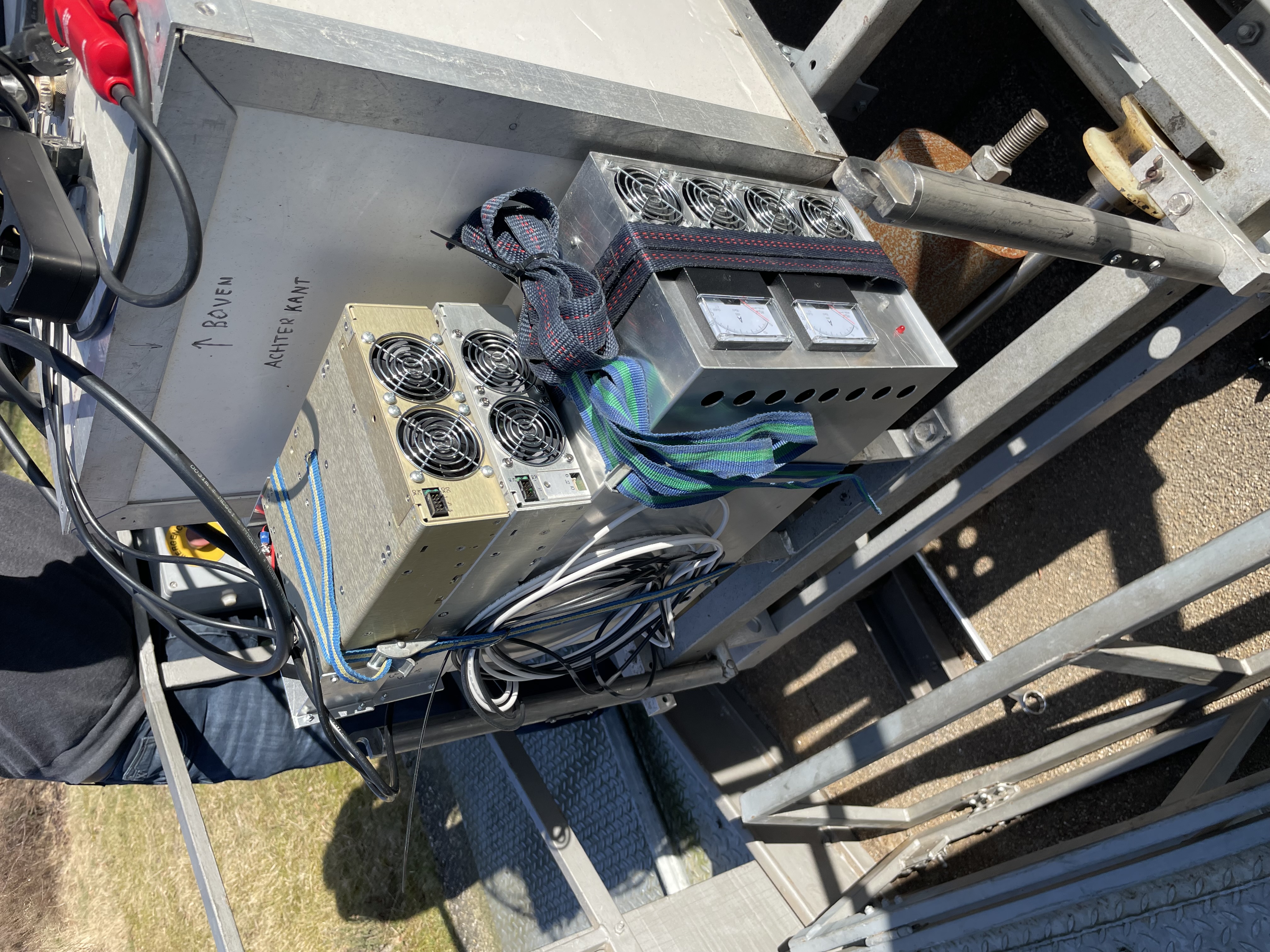 PI9RD EVE feed
PI9RD EVE feed
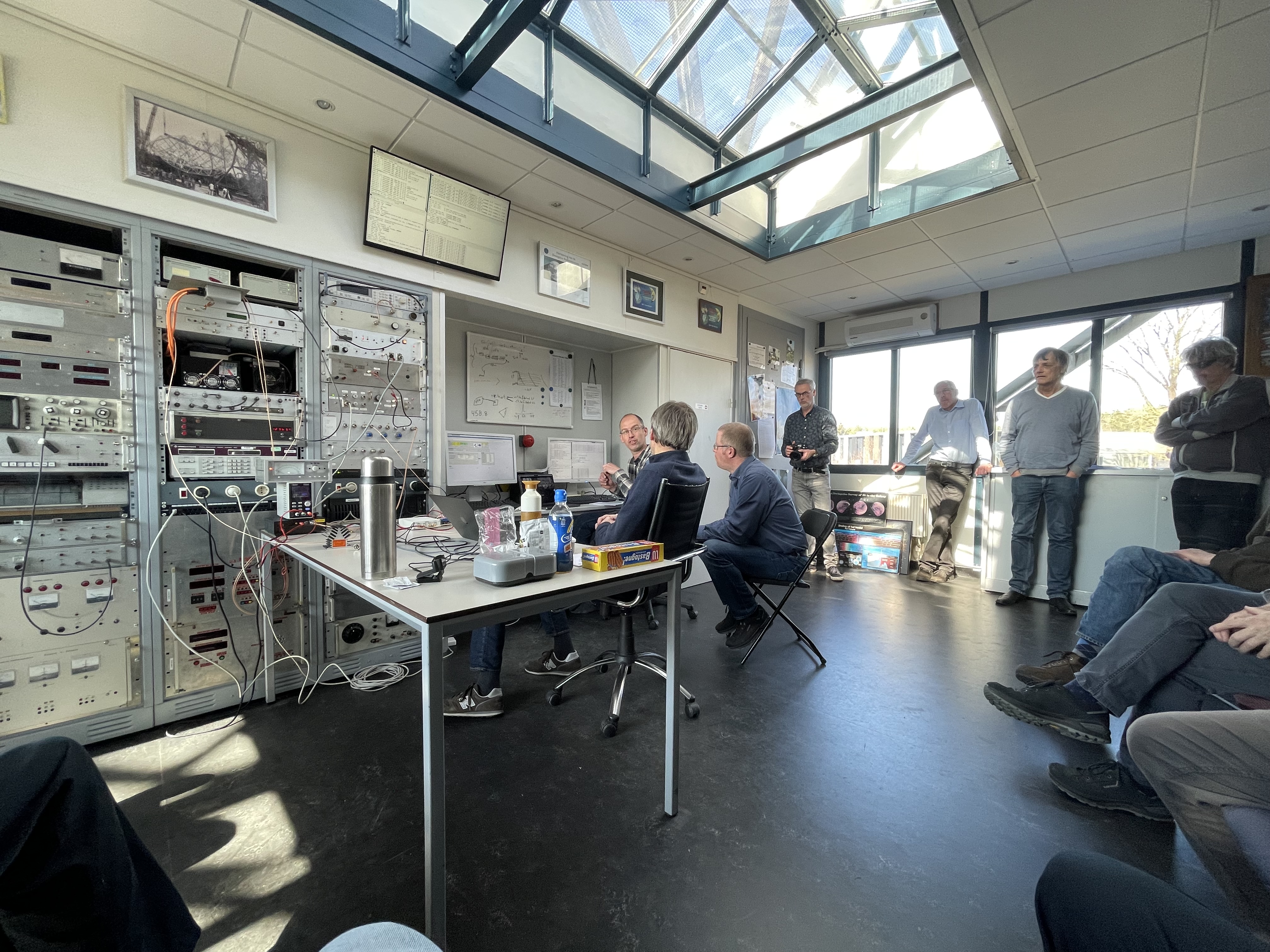 PI9RD control room
PI9RD control room
WSJT-X-improved
DL3WDG Charlie
WSJT-X-improved is branch of WSJT-X from Uwe DG2YCB, who is a member of the WSJT core development team. WSJT-X-improved v2.8.0 was released on 14 Mar 2025 and can be downloaded from Uwe's Sourceforge page at:
https://sourceforge.net/projects/wsjt-x-improved/files/WSJT-X_v2.8.0/
The User Guide is available online at:
https://wsjt-x-improved.sourceforge.io/wsjtx-main_en.html
WSJT-X -improved has its own User Group, to which questions about support etc. can be sent after subscribing here:
https://sourceforge.net/p/wsjt-x-improved/mailman/
Section 1.2 of the User Guide outlines all the new features of v2.8.0, which are explained in more detail in Section 16. Scope and use of the TX Shift feature can be found in Section 10.8.
For EME operators, the new features are:
- TX shift: This allows fully Doppler compensated frequency control of different RX and TX frequencies within a given band, if your rig will support it. It can be useful for operations for example on 1296/1298, 1296/1268 or 2304/2320. The TX frequency can be shifted by up to +/- 30 MHz (in 1 MHz increments).
- 15 s sub-modes: It is now possible to decode signals with EME delay using Q65-15A, B and C submodes. This is intended for experimental use, to evaluate the usefulness of 15 s periods. 15 s decoding is not available in QMAP. QSOs have already been made during the test phase.
- New buttons for selecting Echo mode, or six preset submodes of Q65, with a single mouse click.
- The Monitor button changes colour if file saving is enabled.
- Optionally, frequency entry in kHz above band edge can now be made without including the letter 'k'. Avoids rig control errors for those of us that sometimes forget the 'k'.
The appearance of the Main Window and Waterfall can be set to the same as WSJT-X 2.7.0, for those who prefer the 'standard' GUIs.
The core code in WSJT-X-improved v2.8.0 is the same as used in WSJT-X v2.7.0, and performs identically in terms of both basic usage and decoding sensitivity.
SSB Funtest 2025 Rules
The 27th 1296 MHz SSB Funtest (The F5SE Memorial Contest) will be on Saturday May 24th from 0000 to 2400 UTC. The declination is moderate, but the path loss is at its lowest – ideal for SSB. The 13 cm SSB Funtest will be on Saturday May 31st. Declination is higher but so is the loss. 13 cm is THE band for SSB EME, if you’ve not tried it before I think you will be amazed.
Please remember Al’s words, “These Funtest Events are intended to be fun”. You do not need to transmit on SSB to participate. CW to SSB and vice-verse exchanges are encouraged and count for points. (Only one QSO between stations is allowed, i.e., you cannot work a station SSB to SSB and SSB to CW for extra points).
Scoring is contact points x number of two letter Grid Sectors (IO, JM, FN, EM ...) x 100. SSB to SSB contacts count as 2 points. SSB to CW (or CW to SSB) count as 1 point. The exchange is your Sector (IO, JM, etc.). Only the 2 sector letters need to be sent and copied by EME. The exchange of signal reports and/or 4-character grids is optional and not required. Operation may be by single or multiple operators from one location with no distinction for scoring will be made. This is a Funtest and meant to be similar to an activity event – the goal is to have fun and to find out how well your system is performing. Communication on Loggers (HB9Q) is allowed.
Logs should be sent to the 432 MHz and above EME Newsletter by email to
DUBUS-REF CW/SSB Contest 2025
23 cm SAT+SUN Apr 5+6 (48h) VK3UM Memorial
9 cm SAT May 3 (24h)
1.2 cm SAT June 21 (24h)
3 cm SUN Jun 22 (24h) K2UYH Memorial
6 cm SAT Jul 19 (24h)
Please send newsletter contributions to Peter G3LTF